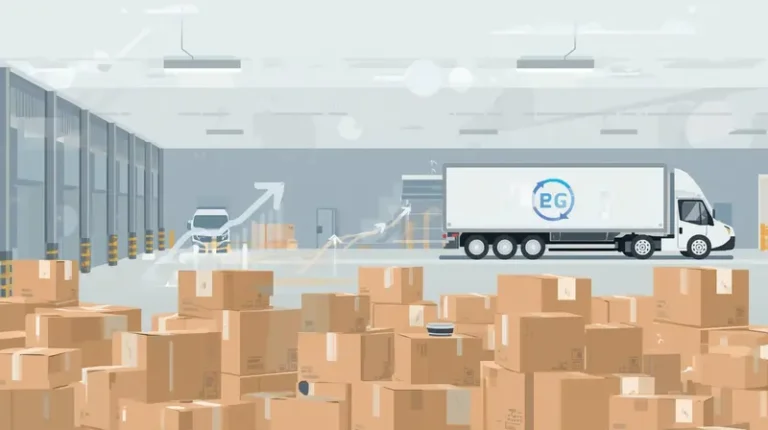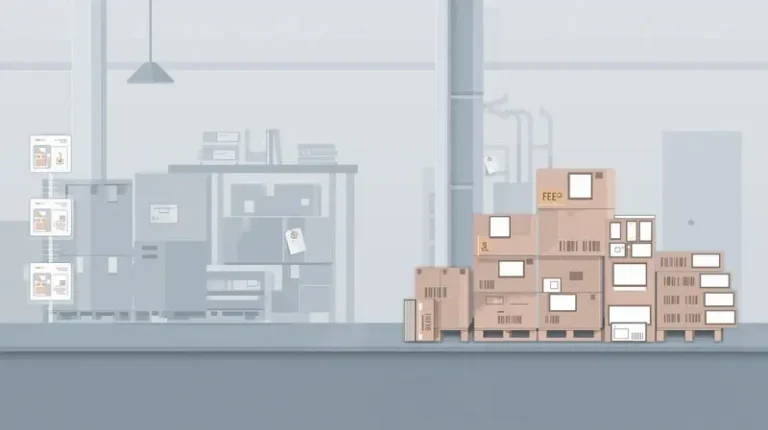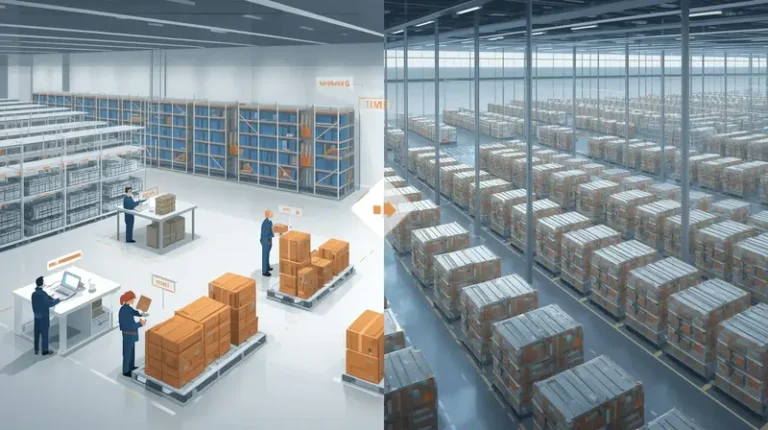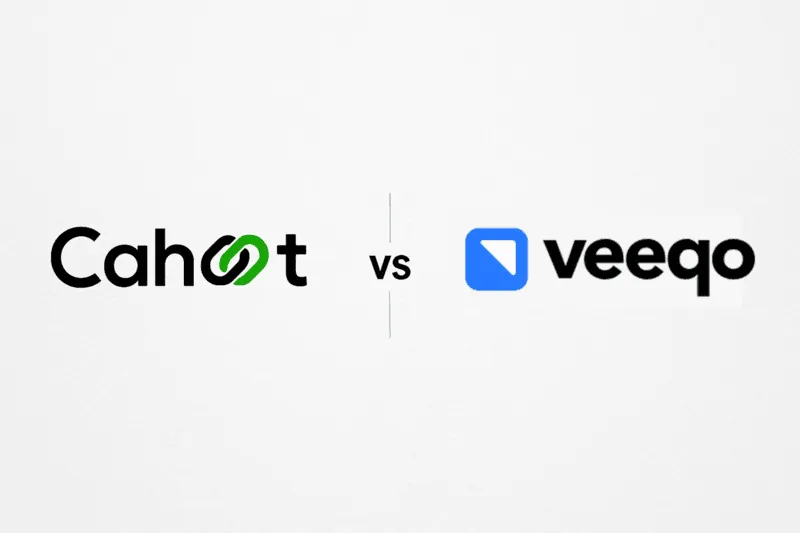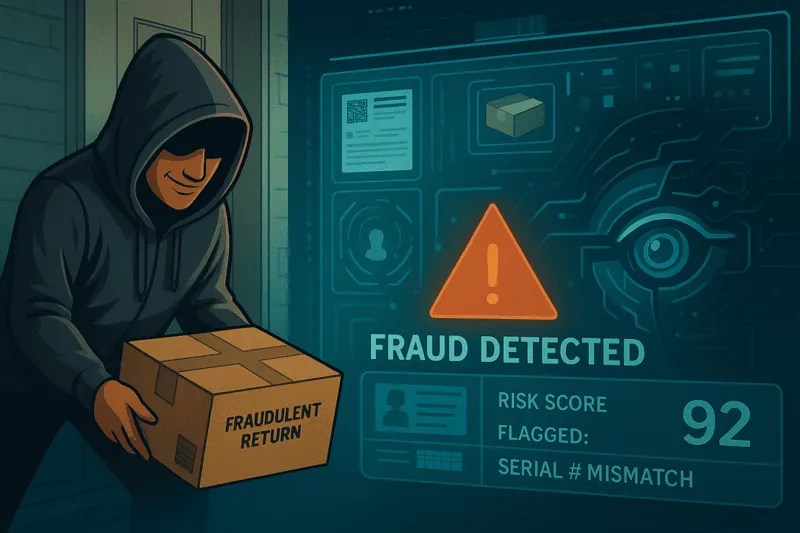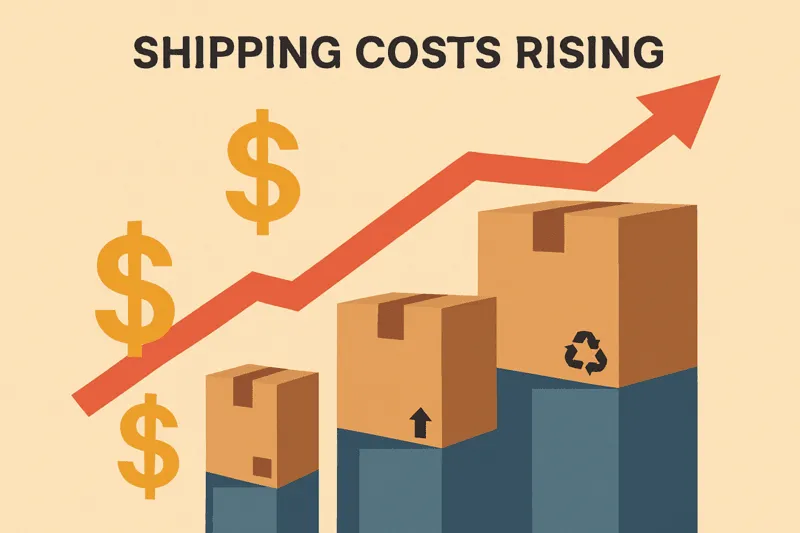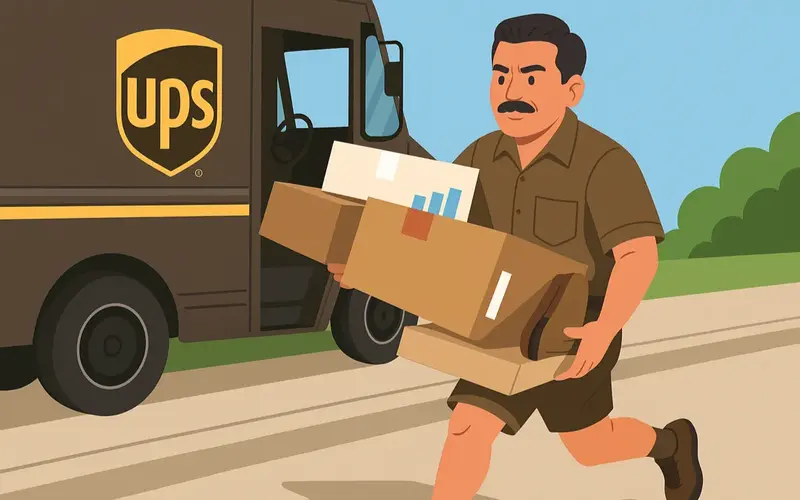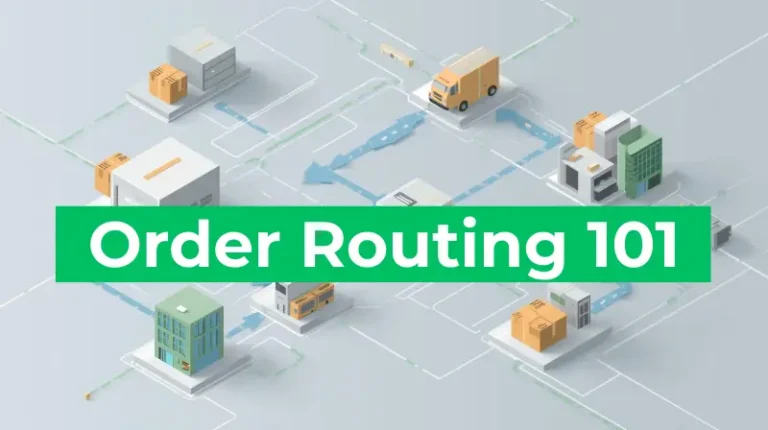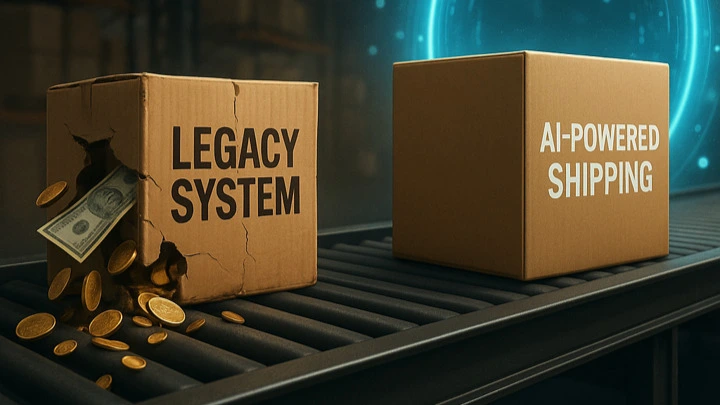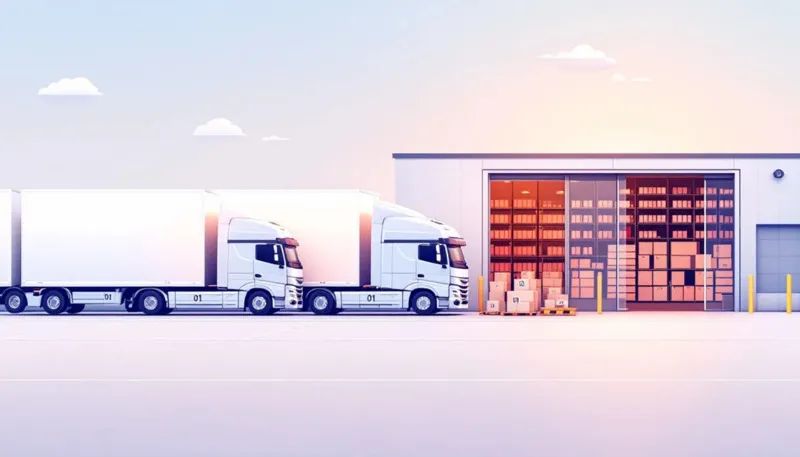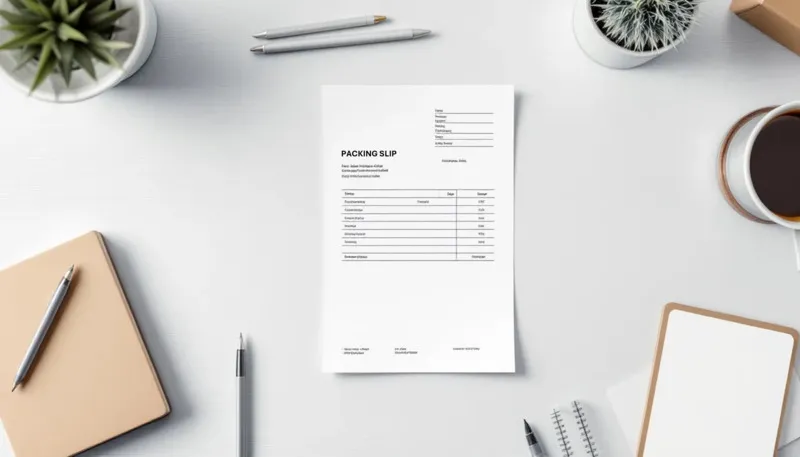Using Rithum to Optimize Multi-Channel Fulfillment and Dropshipping
In this article
 9 minutes
9 minutes
- What Is Rithum?
- Rithum at a Glance
- Core Capabilities: Rithum Modules Explained
- Why Rithum Matters for Modern Commerce
- Use Case: A Dropshipping Brand Using Rithum
- Brands and Retailers Benefiting from Rithum
- Challenges to Be Aware Of
- How Rithum Compares to Other Platforms
- Where Cahoot Fits In
- Final Thoughts
- Frequently Asked Questions
Rithum isn’t just a rebrand, it’s a reinvention. Born from the merger of ChannelAdvisor, CommerceHub, and DSCO, Rithum is now one of the most powerful platforms for brands, retailers, and suppliers navigating the connected ecommerce world. According to Rithum’s CEO, the rebrand marks the beginning of a new era focused on innovation, growth, and supporting customers at every stage of their journey. With over $50 billion in GMV flowing through its pipelines annually, Rithum is quietly powering some of the world’s greatest brands, and making optimized consumer shopping journeys feel seamless.
If your ecommerce strategy includes multi-channel order fulfillment, dropshipping, and scalable growth, Rithum might be the platform you didn’t know you needed. Rithum supports businesses from the very beginning of their ecommerce journey, streamlining onboarding and initial setup to ensure a smooth start.
What Is Rithum?
Rithum is a multi-module platform focused on creating connected ecommerce experiences. It brings together marketing, commerce, delivery, and discovery into one scalable solution, helping brands and retailers operate more efficiently across marketplaces, DTC sites, retail media networks, and fulfillment channels. Rithum is designed to help launch, manage, and grow any type of ecommerce business, supporting the entire commerce operation from inventory management to multi-channel sales.
In other words, Rithum gives you the tools to grow sales, manage inventory, expand fulfillment, automate operations, and scale, all from a centralized command center. It’s built for the brands, retailers, and suppliers who want to stop juggling disconnected systems and finally integrate everything, supporting users every step of the way as they integrate their systems.
Slash Your Fulfillment Costs by Up to 30%
Cut shipping expenses by 30% and boost profit with Cahoot's AI-optimized fulfillment services and modern tech —no overheads and no humans required!
I'm Interested in Saving Time and MoneyRithum at a Glance
- Annual GMV: $50+ billion
- Order Volume: Over 400 million orders processed per year
- Products Listed: 2.4 billion+ SKUs across 420+ channels
- Customer Base: 40,000+ companies, including major global retailers and niche DTC brands
- Trusted by the industry’s leading retailers and brands: Rithum supports the growth and profitability of retailers and brands across the ecommerce ecosystem.
- Legacy: Combines the capabilities of ChannelAdvisor, CommerceHub, DSCO, Cadeera, and more
That’s not just a lot of scale, it’s a lot of trust. Rithum powers commerce infrastructure for companies ranging from Fortune 500 retailers to fast-growing ecommerce entrepreneurs. As the industry’s most trusted commerce platform, Rithum delivers comprehensive solutions for retailers and brands navigating today’s market challenges.
Core Capabilities: Rithum Modules Explained
Rithum’s strength lies in its modular architecture. Businesses can tap into one, two, or all four of the core modules depending on their needs. Rithum supports businesses at every step, whether they choose a single module or implement the full suite, ensuring a smooth progression through each stage of their journey.
1. Commerce Solutions
This is the backbone. Rithum enables sellers to list products across hundreds of marketplaces, websites, social platforms, and retail sites, streamlining data sync, inventory updates, and pricing strategies.
Whether it’s Amazon, Walmart, Target Plus, Zalando, or your own Shopify site, Rithum’s software lets you manage product listings from one place. You can push updates to every sales channel instantly and reduce the lag that costs time, money, and customers.
2. Marketing Solutions
Rithum helps brands drive performance across paid search, social ads, and retail media networks. Think: Google Shopping, Meta Ads, Instacart, Criteo, Roundel, CitrusAd, you name it.
You can create optimized campaigns directly inside Rithum’s platform and integrate with leading analytics tools to tie ad spend to order fulfillment and margin impact. This means tighter control over ROAS, and faster decisions on what’s working and what isn’t.
3. Delivery Solutions
Order fulfillment isn’t just about speed, it’s about flexibility. Rithum’s delivery solutions automate routing based on inventory availability, warehouse proximity, shipping method, and cost-efficiency. This includes direct-to-consumer fulfillment, third-party logistics (3PL), and dropshipping.
Even better, Rithum integrates with Amazon MCF (Multi-Channel Fulfillment), letting brands use Amazon’s fulfillment infrastructure for non-Amazon orders. This creates margin advantages without the overhead of managing your own warehouses (though it’s quite a bit more expensive than outsourcing to 3PLs).
4. Discovery Solutions
Using AI and behavioral data, Rithum identifies top-performing suppliers, curates catalogs for buyers, and matches brands with new retail partners. This is especially powerful for B2B marketplaces and dropship networks looking to expand their assortments strategically.
The goal? Help suppliers work smarter, not harder, and give buyers access to high-margin, in-demand products without wasting time.
Why Rithum Matters for Modern Commerce
Let’s face it: managing ecommerce operations across 10+ sales channels is chaos without a platform like Rithum. The industry’s top brands use Rithum to automate, integrate, and grow. Here’s how:
1. Unified Inventory Management
Forget spreadsheets. Rithum provides real-time inventory visibility across all your selling channels. This helps reduce stockouts, improve fill rates, and prevent costly overselling.
2. Streamlined Order Fulfillment
Orders from Amazon, Shopify, Walmart, and your DTC site all route through a single order management system. Rithum auto-selects the best fulfillment method, be it internal warehouse, dropship partner, or Amazon MCF.
3. Data-Driven Marketing
Tie your product data to your ad performance. Rithum’s platform ensures that your marketing campaigns reflect inventory levels, promotions, seasonal trends, and shipping timelines.
4. Optimized Margins at Scale
One of the most underrated advantages of using Rithum is margin optimization. By automating fulfillment and identifying cost-saving delivery solutions, you increase profit per unit while maintaining fast delivery speeds.
5. Powerful Integrations
Rithum offers prebuilt connections with all major ecommerce platforms, marketplaces, and ERPs. Whether you’re using NetSuite, BigCommerce, Adobe Commerce, or Salesforce Commerce Cloud, Rithum plays nicely in the sandbox.
Looking for a New 3PL? Start with this Free RFP Template
Cut weeks off your selection process. Avoid pitfalls. Get the only 3PL RFP checklist built for ecommerce brands, absolutely free.
Get My Free 3PL RFPUse Case: A Dropshipping Brand Using Rithum
Let’s walk through a simplified scenario:
1. A brand lists 10,000 SKUs using Rithum’s commerce solution.
2. Rithum syndicates those listings to Amazon, Walmart, and a DTC site.
3. Inventory levels sync across platforms in real-time.
4. Orders start coming in from all channels.
5. Rithum routes the orders to a mix of 3PL warehouses and dropship suppliers based on margin and speed.
6. The marketing team uses Rithum’s tools to launch ad campaigns based on best-sellers and restock timelines.
7. The operations team reviews delivery metrics and margin performance using Rithum’s dashboard.
8. The brand expands to a European marketplace, using Rithum’s localization features and supplier discovery module.
Rithum enables brands, retailers, and suppliers to work together seamlessly throughout the dropshipping process, ensuring efficient collaboration and smooth order fulfillment.
From listing to delivery, everything flows through one platform, Rithum, acting as the heartbeat of your dropshipping operation and keeping every part running smoothly.
Brands and Retailers Benefiting from Rithum
Retailers like Belk used Rithum to onboard over 500,000 SKUs in under 90 days, resulting in a 36% YoY increase in GMV. Similarly, brands like Superdry and Marks & Spencer have leaned on Rithum’s marketing automation and fulfillment capabilities to grow international sales and reduce channel friction.
For smaller companies, the appeal is just as strong. Rithum lets lean ecommerce teams punch above their weight, automating order fulfillment, syncing inventory, and scaling ad campaigns without adding headcount.
Challenges to Be Aware Of
No platform is perfect. Here are a few potential drawbacks:
- Complex Onboarding: Rithum’s capabilities are powerful, but not plug-and-play. Implementation often requires a dedicated team or integration partner.
- Cost Structure: After the ChannelAdvisor/CommerceHub merger, some users reported pricing increases of 4–7x. Smaller businesses may need to weigh the ROI carefully.
- Support Transition: With consolidation comes some turbulence. Support quality can vary depending on your plan, region, and internal rep.
Still, these challenges are manageable if you’re serious about long-term scale.
How Rithum Compares to Other Platforms
|
Platform
|
Strengths
|
Weaknesses
|
|---|---|---|
|
Rithum
|
Unified commerce, delivery, marketing
|
Complex onboarding, premium cost
|
|
Zentail
|
Easy setup, automation
|
Fewer marketplaces supported
|
|
Feedonomics
|
Robust product feed optimization
|
Limited fulfillment capabilities
|
|
Skubana
|
Inventory automation
|
Light on marketing tools
|
|
Cahoot
|
Fastest fulfillment via P2P network, most profitable reverse logistics
|
Primarily focused on shipping/logistics
|
Rithum is ideal for businesses seeking an end-to-end platform that supports everything from product discovery to last-mile delivery, especially if those businesses operate across multiple sales channels and want to optimize every piece of the puzzle.
To see how Rithum can help your business, schedule a demo to view the platform in action and learn more about its features and benefits.
Scale Faster with the World’s First Peer-to-Peer Fulfillment Network
Tap into a nationwide network of high-performance partner warehouses — expand capacity, cut shipping costs, and reach customers 1–2 days faster.
Explore Fulfillment NetworkWhere Cahoot Fits In
For ecommerce sellers using Rithum but seeking faster, more cost-efficient fulfillment, Cahoot can be a perfect complement. While Rithum automates order routing and marketplace connections, Cahoot offers peer-to-peer fulfillment with 1-day ground delivery coverage across the U.S., at rates that beat most traditional 3PLs.
By integrating Cahoot into the Rithum workflow, brands can unlock smarter delivery solutions that drive higher margins and better customer experiences.
Final Thoughts
Rithum is more than just a new name; it’s a new rhythm for ecommerce. By merging legacy giants like ChannelAdvisor and CommerceHub, the Rithum platform is enabling connected ecommerce experiences at scale. With modules for commerce, marketing, delivery, and supplier discovery, it empowers brands, retailers, and suppliers to build lasting commerce businesses. Rithum also offers valuable resources to support teams and foster community within the ecommerce ecosystem.
It’s not for the faint of heart. Implementation takes planning. Costs can add up. But for ecommerce teams aiming to automate, scale, and integrate across channels, Rithum delivers.
Whether you’re launching a DTC brand, scaling a supplier network, or operating as one of the world’s greatest brands, Rithum helps create the infrastructure needed to move at speed, sell with confidence, and thrive in a fragmented retail world. Users love the seamless experience and impressive results they achieve with Rithum.
Frequently Asked Questions
What is Rithum, and what companies is it built from?
Rithum is a connected ecommerce platform formed by merging ChannelAdvisor, CommerceHub, DSCO, and other technology providers. It supports global brands, retailers, and suppliers.
How does Rithum improve order fulfillment and delivery solutions?
Rithum automates order routing across warehouses, dropship suppliers, and Amazon MCF, helping companies optimize shipping speed, cost, and customer satisfaction.
Which types of businesses should use Rithum?
Rithum is best suited for ecommerce brands, retailers, and suppliers managing sales across multiple marketplaces who need scalable software for fulfillment, marketing, and inventory.
Does Rithum offer tools for marketing and retail media?
Yes, Rithum’s marketing solutions connect directly to platforms like Google, Meta, Instacart, and retail media networks, helping businesses drive optimized consumer shopping journeys.
How does Rithum help brands expand globally?
Rithum’s commerce and discovery modules allow brands to manage listings across 420+ channels, onboard new suppliers, and localize product data to grow into new markets efficiently.

Turn Returns Into New Revenue
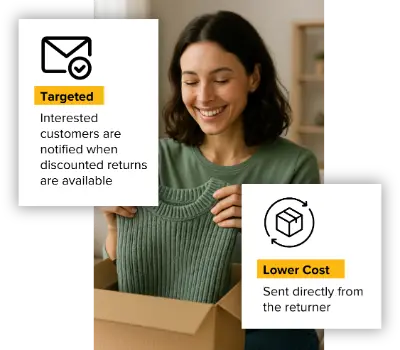
Cahoot vs Veeqo: A Value-Driven Comparison for Modern Ecommerce Sellers
In this article
 9 minutes
9 minutes
- At a Glance: Cahoot vs Veeqo
- Pricing Models & Carrier Rates
- Order Routing & Workflow Automation
- Multi-Channel Capabilities
- Inventory & Warehouse Management
- Support & Learning Curve
- Amazon Buy Shipping & SFP
- Data You Can Actually Use
- Built for Amazon Sellers, but Not Owned by Amazon
- Pros & Cons
- Cahoot vs. Veeqo: What Sellers Are Saying
- Final Verdict
- Frequently Asked Questions
When ecommerce sellers start scaling across marketplaces like Amazon, eBay, Walmart, and Shopify, their shipping software can either accelerate that growth or slow them down. Two platforms built to handle multi-channel shipping are Veeqo and Cahoot. Both offer discounted shipping labels and order management tools, but the similarities end there. This in-depth comparison will explore what each software delivers, what it lacks, and which one ultimately supports fast-moving ecommerce teams better.
At a Glance: Cahoot vs Veeqo
|
Feature
|
Cahoot
|
Veeqo
|
|---|---|---|
|
Multi-Channel Order Import
|
Yes
|
Yes
|
|
Discounted Carrier Rates
|
Yes
|
Yes
|
|
Rate Shopping Across Carriers
|
Yes
(Autonomous) |
Yes
(Basic) |
|
Bulk Label Printing
|
Yes
(Autonomous) |
Yes
(Traditional) |
|
Support for Own Carrier Accounts
|
Yes
|
Yes
|
|
Automation Rules & Order Routing
|
Yes
(Highly Configurable) |
Limited to Presets
|
|
Intelligent Package Selection (Cartonization)
|
Yes (AI-powered)
|
No
|
|
WMS Features
|
Yes
|
Partial
|
|
Inventory Visibility
|
Yes
(real-time) |
Yes
(limited granularity) |
|
Returns Workflow Integration
|
Optional Peer-to-Peer Returns
|
Basic RMA
|
|
Live Customer Support
|
Yes
(Help Desk, Phone) |
No phone support
|
|
Amazon Buy Shipping API Certified
|
Yes
|
Yes
|
|
Supports Amazon SFP
|
Yes
|
No
|
|
Open to 3PLs
|
Yes
|
No
|
Pricing Models & Carrier Rates
Both Cahoot and Veeqo offer access to discounted shipping rates from major carriers like UPS, FedEx, and USPS. Veeqo highlights its access to Amazon-negotiated carrier rates, especially beneficial for FBM sellers. However, it’s worth noting that Cahoot also offers deeply discounted rates through its aggregated carrier network, and unlike Veeqo, sellers aren’t required to be Amazon merchants to access them.
Users have praised Veeqo’s rates in particular, though some feel that the real-world savings depend on volume and location. One user on Trustpilot noted, “Veeqo offers good rates, but it doesn’t always beat what I negotiated directly with FedEx.” That said, having an option for both Veeqo and using your own account provides flexibility.
Cahoot lets sellers compare real-time rates across carriers, or even better: automate all the rate shipping and bulk shipping label generation based on the desired logic (cheapest, fastest, delivery promise, signature-required, etc.). This level of autonomous support (removing the human) goes a step further than Veeqo’s more manual workflows.
Order Routing & Workflow Automation
This is where the gap between the two platforms widens. Cahoot excels at automation.
Cahoot’s rule engine lets sellers automatically assign orders to specific warehouses, select packaging based on product dimensions, and pick carriers based on dynamic rules. It includes AI-powered cartonization, reducing overpackaging and optimizing label selection at scale. This feature alone can save high-volume shippers thousands per month.
Veeqo supports some automation, but according to multiple reviews, the rules engine lacks flexibility. As one user put it: “You can automate some parts of the shipping process, but complex routing logic just isn’t possible.” Another noted on G2, “Our warehouse team constantly has to manually override presets in Veeqo to get the right shipping option.”
Cahoot also offers the option to import product master data, assign SKUs to multiple warehouses, and automate routing for distributed fulfillment. These features are especially helpful for sellers managing multiple sales channels and warehouse locations.
Multi-Channel Capabilities
Both platforms support multi-channel order import from Amazon, eBay, Shopify, Walmart, Etsy, and more. Veeqo is tightly integrated with Amazon (it’s owned by Amazon), which brings advantages for FBM sellers, like access to Buy Shipping and automated order syncing.
However, some sellers note that Veeqo prioritizes Amazon workflows and that the support for non-Amazon channels lacks depth. A Trustpilot reviewer stated, “It’s clearly built with Amazon in mind. Shopify orders don’t always sync correctly, and the custom mapping is limited.”
Cahoot offers native integrations with all major ecommerce platforms, with equal priority across sales channels. That neutrality is useful for brands expanding beyond Amazon and looking to centralize operations across multiple storefronts.
It also means Cahoot isn’t limited by Amazon policy shifts or ecosystem changes. For businesses hoping to grow a multi-platform brand, that independence matters.
Inventory & Warehouse Management
Veeqo includes basic inventory tracking tools but doesn’t offer a full warehouse management system (WMS). Its UI shows available stock and syncs between platforms, but lacks pick/pack workflows, barcode scanning, and location-based inventory management.
Cahoot includes WMS features as part of the platform, with no need for third-party plugins. Sellers can assign bin locations, manage cycle counts, and generate pick lists automatically. One Cahoot user shared, “We reduced picking errors by 60% after switching from ShipStation to Cahoot because the WMS features are built in.”
For growing brands with even modest warehouse operations, this difference is key. It consolidates tech stack complexity and reduces reliance on disconnected tools.
Support & Learning Curve
Cahoot provides live onboarding, in-platform chat, and phone support. Multiple users note how responsive the support team is. One review on G2 says, “Every time I had an issue, Cahoot got back to me within minutes. I never felt like I was waiting around.”
Veeqo, on the other hand, has no phone support, and several users on Trustpilot and Reddit cite frustrating support delays. One review read, “You submit a ticket and wait… sometimes for days. It’s not great when your entire shipping flow is paused.”
Veeqo also has a steeper learning curve for non-Amazon users. The dashboard is robust but not intuitive for sellers focused on Shopify or direct-to-consumer models.
Amazon Buy Shipping & SFP
Both platforms are certified for Amazon Buy Shipping, meaning they help sellers remain compliant with Amazon’s policies and tracking requirements. However, only Cahoot supports Seller Fulfilled Prime (SFP).
For Amazon SFP sellers, this is a major differentiator. Cahoot’s compliance engine ensures same-day label printing, cut-off time enforcement, and late-delivery prevention. Veeqo does not support this, which rules it out for many brands trying to maintain the Prime badge.
Data You Can Actually Use
With Veeqo, many sellers are flying blind. Sales data is fragmented. Shipping costs aren’t always transparent. And pulling that data often means wrangling spreadsheets with missing headers or running into failed exports.
Cahoot makes it easy to analyze profits, understand shipping costs, and track eligible shipments in one dashboard. You get full access to real performance data without needing to bounce between platforms.
Built for Amazon Sellers, but Not Owned by Amazon
Veeqo is owned by Amazon. That means anything you do on the Amazon platform is potentially visible. For Amazon sellers trying to protect their strategy or operate across other channels, that’s a problem.
Cahoot is fully compatible with Amazon FBM, FBA, and Buy Shipping, but stays independent. You get the lowest rates available, without locking yourself in deeper with Amazon or giving up your leverage.
Pros & Cons
Cahoot vs. Veeqo: What Sellers Are Saying
“Using Veeqo costed us so much time. Exports kept failing, inventory didn’t match, and the UI was just confusing. Cahoot gave us back control.”
~ Multichannel seller, apparel industry
Speak to a fulfillment expert
“The only reason I stuck with Veeqo was because it was free. But once our shipping volume increased, we needed more, and Cahoot delivered.”
~ Electronics brand owner
Speak to a fulfillment expert
Final Verdict
Veeqo is a solid, free tool for Amazon-first sellers who want to print shipping labels and access decent rates with minimal setup. But it lacks depth in automation, support, and warehouse operations.
Cahoot, by contrast, is built for scale. It’s ideal for ecommerce brands that are serious about operational efficiency and growth. From smart automation to robust warehouse tools and superior customer support, Cahoot is the better long-term investment for sellers looking to streamline operations across multiple platforms.
If you’re running a high-volume ecommerce business that ships across multiple sales channels, handles inventory in multiple locations, or simply wants to reduce costs and errors at scale, Cahoot is the clear winner.
Don’t settle for free if it slows your business down.
Choose smarter. Explore how Cahoot can simplify your shipping and scale with your brand.
Frequently Asked Questions
Is Veeqo really free, and what’s the catch?
Yes, Veeqo is technically free, but many sellers report that key features like bulk shipping, inventory management, and reporting are limited. You may still need your own carrier accounts, and support can be slow.
How does Cahoot’s shipping software help reduce shipping costs?
Cahoot gives sellers access to discounted rates across major carriers like UPS, FedEx, and USPS, with no Veeqo credits or software bugs required. Plus, bulk shipping tools and data-driven insights help optimize your entire shipping process.
Can I use Cahoot if I sell on Amazon and other ecommerce channels?
Absolutely. Cahoot supports multiple sales channels, including Amazon, Walmart, eBay, and Shopify, while keeping inventory levels synced across all platforms. Unlike Veeqo’s integration, Cahoot’s system is fast, clean, and flexible.
What makes Cahoot better for inventory management than Veeqo?
Cahoot simplifies multi-channel inventory with real-time stock tracking, automated syncing, and alerts to prevent overselling. Veeqo users often struggle with managing inventory across platforms due to sync lags and poor data visibility.
Why do sellers leave Veeqo for Cahoot?
Many sellers switch when they realize Veeqo’s free model comes with trade-offs: limited support, Amazon ownership, clunky UI, and frustrating data export issues. Cahoot offers a full-featured, seller-first solution that saves time and drives smarter decisions.

Turn Returns Into New Revenue

How AI-Powered Cahoot Returns Management Reduces Ecommerce Fraud
In this article
 9 minutes
9 minutes
- The Real Cost of Returns Fraud
- How AI Detects Fraud in the Returns Process
- How Cahoot Uses AI to Catch Return Fraud Before It Hits Your Warehouse
- How AI Preserves Customer Trust
- Behind the Scenes: What AI Actually Looks At
- The Business Benefits
- Final Thoughts: AI Is the Future of Fraud Prevention
- Frequently Asked Questions
Fraudulent returns and refund abuse are eating into ecommerce profits like termites in a timber shack. We’re not just talking about a few bad actors. This is a systemic issue. Every time someone pulls a fast one, returning a used dress, faking a receipt, or claiming a package never arrived, ecommerce businesses bleed money. But here’s the good news: AI is finally catching up.
Businesses that implement AI-powered fraud detection tools gain a competitive advantage in the ecommerce space, reducing losses and improving operational efficiency.
This article explores how AI-powered returns management is giving merchants the upper hand, using machine learning and advanced fraud detection tools to sniff out shady behavior while keeping the experience smooth for legitimate customers. The tech is here, it’s learning fast, and it’s reshaping how we handle ecommerce returns.
The Real Cost of Returns Fraud
Returns fraud isn’t just annoying, it’s financially devastating. Think about:
- Wardrobing: Wear once, return as “new”.
- Switch fraud: Return a knockoff and keep the real thing.
- Empty box scams: Return a box with no item inside, claim it’s there.
- Refund fraud: Claim the item never arrived, even when it did.
Customers exploit return policies by making false claims about product defects or delivery issues, manipulating the system for personal gain. Fraudulent return activities also include stolen merchandise returns and targeting high-value items such as luxury goods.
All of these fall under fraudulent returns and refund fraud, and they’re on the rise. According to the National Retail Federation, ecommerce losses from return abuse now top tens of billions of dollars annually.
AI analyzes return data and return patterns to identify patterns and fraud patterns in return transactions, helping businesses detect and prevent evolving forms of return fraud.
The old methods, manual checks, strict return policies, and restocking fees, aren’t cutting it anymore. They hurt genuine customers and barely scratch the surface of sophisticated scams. That’s where AI fraud detection for ecommerce returns steps in.
How AI Detects Fraud in the Returns Process
AI-powered returns management combines machine learning algorithms, transaction data, returns data, and customer behavior to spot bad actors before they strike. AI-powered systems are designed to prevent fraud throughout the returns process. Here’s how:
1. Photo Verification & Image Recognition
AI can evaluate customer-submitted images of returned items to:
- Detect box fraud or item switching.
- Compare the product’s appearance to a verified new version.
- Identify wear, missing parts, or damage that contradicts the return reason.
This allows brands to detect fraudulent activity before it’s even shipped back.
2. Pattern & Anomaly Detection
Machine learning excels at spotting unusual patterns in behavior:
- Return frequency: Has the customer returned too many high-value items?
- Geolocation: Is the return request coming from a region known for return scams?
- Purchase timing: Did they buy during a sale and return right after peak season?
These patterns raise fraud risks and trigger review or denial workflows.
3. Cross-Platform and Channel Monitoring
AI systems can check across multiple returns and ecommerce channels, identifying if a return was initiated:
- For the same item on multiple platforms.
- Using fake receipts.
- From a buyer who already claimed store credit somewhere else.
AI can also monitor for account takeover attempts by detecting unusual account activities, such as frequent address changes, excessive returns, or high-value purchases. When suspicious account activity is detected, AI can recommend enabling multi-factor authentication to add an extra layer of security and prevent unauthorized access.
This multi-touch intelligence is a game-changer for fraud prevention goals.
4. NLP for Reason Analysis
Natural language processing (NLP) can analyze written return reasons and flag:
- Repeated use of vague claims like “defective”.
- Scripted language that suggests fraud rings.
It’s subtle, but over time, it sharpens fraud detection and helps businesses adapt.
5. Smart Risk Scoring
With returns management systems like Cahoot, each return is assigned a fraud risk score based on:
- Customer history
- Returns data
- Known red flags like frequent returns, high-value items, high-risk transactions, or mismatched shipping info
High-risk returns may trigger:
- Photo verification
- Manual review
- Limited refunds (e.g., store credit only)
How Cahoot Uses AI to Catch Return Fraud Before It Hits Your Warehouse
Here’s the short version: Cahoot’s AI-powered returns system sniffs out sketchy returns before they even hit your dock. No detective hats or magnifying glasses required. It’s proactive fraud prevention baked right into the returns process, built for ecommerce teams who don’t have time (or money) to waste on refund fraud and box scams.
Here’s how it plays out in real life: a customer clicks “return,” and instead of handing them a prepaid label like candy at a parade, Cahoot asks for photos. Item, packaging, maybe even the serial number. That’s when the AI kicks in, checking everything against the original order. Does the item match what was sold? Is the box suspiciously light? Are they trying to return a broken knockoff instead of the actual product? The system flags anything that smells off. No human has to squint at a blurry JPEG; AI’s doing the heavy lifting.
And if things look really fishy? Cahoot assigns a fraud risk score based on the customer’s history, return frequency, location, and transaction data. Say this person’s been sending back a lot of high-value items or triggering patterns tied to refund fraud, Cahoot might put the brakes on the refund, sending it to manual review or straight-up denying it. It’s like having a savvy fraud analyst on call, 24/7, who doesn’t need coffee breaks.
But that’s not all, it gets sharper with every return. The system learns what fraud looks like. Maybe it flags addresses linked to repeat offenders. Maybe it notices “this person always returns luxury goods two days before the return window closes.” The more it sees, the smarter it gets. Over time, it recommends policy tweaks that actually make sense, like tightening windows for excessive returns or requiring restocking fees on high-risk items.
Cahoot also checks serial numbers in real time. That means box fraud, where someone swaps the product and sends back a decoy, gets stopped cold. If the serial number doesn’t match what was sold? Game over. No refund. No restock. Just one more fake return that never made it through the door.
All of this happens quietly in the background, streamlining the returns process for good customers while catching the bad ones red-handed. That’s the beauty of machine learning in ecommerce returns: it doesn’t just react, it predicts. And when refund fraud can bleed your margins dry faster than a flash sale, that kind of protection isn’t just nice to have, it’s essential.
Cahoot’s AI isn’t trying to micromanage your returns team; it’s giving them superpowers. So your operations run leaner, your legit customers stay happy, and your profits stay where they belong. In your pocket.
How AI Preserves Customer Trust
One of the trickiest parts of returns fraud is not alienating loyal customers. Efficient returns processes powered by AI improve customer satisfaction by reducing friction and delays. A good AI doesn’t just block fraud, it enables a positive customer experience by:
- Fast-tracking legitimate customers
- Preventing false positives through layered detection
- Using customer verification sparingly and intelligently
In short, it finds the right balance between fraud prevention and a frictionless returns process.
Behind the Scenes: What AI Actually Looks At
This isn’t black magic, it’s smart automation trained on mountains of data:
- Historical data: Past behaviors of repeat offenders and loyal shoppers
- Data points: Shipping speed, order value, return time frame
- Customer data: Addresses, accounts, payment histories
- Delivery tracking: GPS drops vs. “item not received” claims
Together, these inputs help detect fraud across a spectrum, from empty box fraud to money laundering via returns.
The Business Benefits
When ecommerce companies implement AI-powered returns management, they see results fast. These benefits contribute to the long-term success of ecommerce businesses:
✔ Reduced Operational Costs
- Less need for manual review
- Faster returns management process
✔ Improved Customer Loyalty
- Quicker refunds for genuine customers
- Confidence that return policies are fair
✔ Higher Margins
- Fewer fraudulent returns and chargebacks
- More high-value items are resold instead of being written off
✔ Smarter Policy Decisions
- AI insights guide better rules
- Target return abuse without punishing everyone
It’s a full-circle win for ecommerce businesses who want to scale securely.
Final Thoughts: AI Is the Future of Fraud Prevention
Return fraud is constantly evolving. So are the tools to fight it. By leveraging AI and machine learning in the returns management space, sellers are turning what used to be a liability into a competitive edge.
With platforms like Cahoot, advanced technology no longer belongs only to the big guys. Even mid-size online stores can now fight receipt fraud, friendly fraud, and return scams with precision.
So next time someone tries to game the system with a personal gain hustle, just remember: AI sees all. And it doesn’t blink.
Frequently Asked Questions
How does AI detect fraudulent returns in ecommerce?
AI fraud detection for ecommerce returns works by analyzing returns data, customer behavior, and product images to identify suspicious patterns. It can flag issues like empty box fraud, receipt fraud, or mismatched serial numbers by comparing return requests against historical transaction data and trained machine learning algorithms.
What is the difference between return abuse and friendly fraud?
Return abuse often involves intentional schemes like wardrobing or box switching for personal gain, while friendly fraud includes tactics like claiming an item was never received to get a refund. Both forms of fraudulent activity are increasing in ecommerce returns, and AI-powered systems help detect these behaviors quickly.
Can AI-powered returns management improve customer satisfaction?
Yes. By separating legitimate customers from bad actors, AI-powered returns management allows genuine customers to experience faster processing, easier refunds, and less hassle, while fraudsters face more scrutiny. This helps maintain customer loyalty, customer trust, and a positive customer experience.
What types of ecommerce return fraud does AI help prevent?
AI helps identify and prevent a range of fraud types, including stolen merchandise returns, false claims, empty box fraud, refund fraud, and return scams. It uses data points like return frequency, image analysis, and customer history to flag high-risk transactions for further review.
Why is AI better than traditional fraud prevention methods?
Unlike manual reviews or blanket return policies that can frustrate loyal customers, AI fraud detection tools use advanced technology to spot fraud patterns in real-time. This results in lower operational costs, stronger fraud defenses, and better long-term success for ecommerce businesses.

Turn Returns Into New Revenue

Strategies to Mitigate FedEx and UPS Surcharges 2025
In this article
 9 minutes
9 minutes
- Why Are These Surcharges Getting Worse?
- What This Means for Your Ecommerce Operation
- 1. Know Your Surcharge Triggers
- 2. Reroute Using Distributed Fulfillment
- 3. Leverage Regional Carriers and USPS
- 4. Negotiate Like a Pro
- 5. Bundle Smart and Reduce Dead Weight
- 6. Offer Incentives to Offset Costs
- 7. Monitor, Adjust, Repeat
- 8. Stay Compliant: Commercial Invoice Requirements
- Final Thoughts
- Frequently Asked Questions
Let’s not sugarcoat it. The 2025 UPS and FedEx surcharges are hitting hard, and if you run an ecommerce business, you’re likely already feeling it in your margins. These aren’t just petty rate hikes; we’re talking residential delivery fees, large package surcharges, and peak season multipliers that could straight-up wreck your bottom line if left unchecked. New surcharges and additional fees can quietly inflate costs for ecommerce businesses if not monitored closely.
So what do we do? Panic? Raise prices? Light a candle? Nah. Let’s talk smart ecommerce shipping strategy. This article will help you identify and address these additional fees before they quietly eat into your profits.
Why Are These Surcharges Getting Worse?
Simple: higher costs for carriers, inflation, delivery network strain, and the never-ending Amazon arms race. Carriers know ecommerce businesses rely on them, and they’re capitalizing on that reliance with complex, hard-to-negotiate fees. To increase revenue, carriers are introducing new surcharges and modifying their pricing structure, resulting in additional revenue streams that shippers must monitor closely.
It used to be seasonal. Now it’s structural. UPS recently added a higher “Additional Handling” fee for packages over 30 pounds, and FedEx followed suit with new zone-based surcharges on bulky items. These changes are part of the evolving UPS surcharges landscape, reflecting how carriers are using new fees and pricing structure adjustments to drive revenue. If your business ships large packages (think fitness gear, small furniture, or bundled orders), you’re in the crosshairs.
What This Means for Your Ecommerce Operation
These aren’t line items you can just absorb. Surcharges and fees affect not just shipping costs but also other aspects of your business, including a new 2 percent payment processing fee on most charges. If you’re not actively working to reduce shipping costs with UPS and FedEx, you’re leaving money on the table, or worse, eating it. That “free shipping” promise starts to feel like a bad joke.
Changes in shipping rates and surcharges can significantly impact shippers’ bottom lines. This is where shipping strategy becomes a profit lever.
1. Know Your Surcharge Triggers
First up: audit your shipments. Where are the fees coming from?
- Oversize or large package fees? (Services affected: typically ground and express shipments)
- Residential delivery? (Services affected: home delivery and residential ground services)
- Peak delivery windows? (Services affected: all expedited and time-definite services)
- ZIP codes with higher fees (“extended area surcharge”)? (Services affected: rural and remote area deliveries; charges subject: extended area surcharges)
Understanding which charges are subject to surcharges for each package shipped is crucial for controlling shipping costs and optimizing your logistics strategy.
Use this data to model scenarios: “What happens if I split shipments differently? Consolidate? Change carriers regionally?”
2. Reroute Using Distributed Fulfillment
If you’re shipping coast-to-coast from a single warehouse, you’re stacking up zone charges. A 4 lb box from NYC to Oregon isn’t the same cost as one going to Jersey.
Using distributed fulfillment cuts zone distance, enables faster delivery, and reduces per-package surcharge exposure, including those related to domestic ground shipping services. This is especially important for large or heavy ecommerce products.
Additionally, consolidating shipments can further minimize surcharge costs.
3. Leverage Regional Carriers and USPS
Don’t let UPS and FedEx think they’re the only game in town. Regional carriers like OnTrac and LSO are expanding coverage and love ecommerce volume. For lighter shipments, USPS remains competitive and immune to many surcharge layers. However, keep in mind that services like UPS Ground Saver® and various air services, including UPS Next Day Air, UPS 2nd Day Air, and international air options, are also subject to changing fuel surcharges, which can impact your shipping costs.
Use carrier rate shopping logic to auto-select the most affordable carrier based on destination, weight, and dimensions, and consider how surcharges on UPS Ground Saver and air services may affect your total rates.
4. Negotiate Like a Pro
Yes, you can negotiate UPS and FedEx rates, but you need leverage. Demonstrating high shipping volume and effectively managing frequent shipments can provide significant bargaining power. Show them your volume growth, historical performance, and willingness to shift volume elsewhere. Push for:
- Waived or reduced surcharges
- Custom DIM divisor
- Discounts for specific ZIPs or package types
- Better terms on traditional shipping rates and all ancillary fees, not just base rates
And don’t just do this once a year. Re-negotiate quarterly if needed.
5. Bundle Smart and Reduce Dead Weight
Product bundling sounds simple until you realize you’re accidentally triggering dimensional weight charges or bumping into a surcharge tier. Optimizing packaging can provide value-added benefits and reduce the risk of incurring extra surcharges.
Use cartonization software or fulfillment logic to optimize what goes in each box. Small tweaks to packaging design or SKU mix can save you thousands.
6. Offer Incentives to Offset Costs
Let your customers help. Offer:
- Store pickup or local delivery discounts
- Extended delivery timelines for lower-cost options
- Free shipping thresholds to encourage higher-margin AOVs
You’re not passing on fees, you’re framing value.
7. Monitor, Adjust, Repeat
Surcharges change quarterly, and as mentioned, fuel surcharges are especially important to monitor as they can significantly bump your shipping costs. Fluctuating fuel prices directly impact how carriers adjust fuel surcharges, so it’s essential to track these changes and adjust your strategies accordingly. Don’t wait for the damage to show up in your P&L. Set up automated reporting by carrier, SKU, zone, and surcharge type. Watch trends.
A client of ours shipping workout gear will trim \$40 K from their shipping budget by simply redesigning two SKUs to avoid “additional handling” fees. Total cost: \$3 K in packaging R&D.
Recent changes include more frequent updates to fuel surcharges based on weekly fuel price indices, and new surcharge structures that can significantly bump costs if not closely monitored. The key takeaway: Stay proactive by tracking all surcharges, especially those affected by fluctuating fuel prices, and be ready to adjust your shipping strategies to minimize the impact on your bottom line.
8. Stay Compliant: Commercial Invoice Requirements
If you think surcharges only hit you at the shipping label, think again. Earlier this year, UPS rolled out a new “Paper Commercial Invoice Service Surcharge,” meaning every time you send a shipment with a paper commercial invoice, you’ll get dinged with an extra fee. For businesses still relying on traditional invoicing methods, this is one more way shipping costs can quietly inflate.
A commercial invoice isn’t just paperwork; it’s a required document for international shipments, detailing what’s in the box, its value, and who’s sending and receiving it. Get it wrong, and you risk delays, compliance headaches, or even more fees. Get it right, and you keep your shipments moving and your costs in check.
To avoid this new surcharge, start paying closer attention to your invoicing processes. Switching to digital form, electronic invoicing (e-invoices) not only helps you dodge the UPS paper invoice fee but also streamlines your shipping workflow and reduces manual errors. Make sure your shipping software or logistics provider supports digital commercial invoice generation and submission.
Bottom line: staying compliant with commercial invoice requirements isn’t just about avoiding penalties, it’s about keeping your shipping costs under control and your business running smoothly. Don’t let outdated invoicing practices add unnecessary fees to every shipment. Embrace digital, stay ahead of the surcharges, and keep your logistics costs lean.
Final Thoughts
The 2025 UPS and FedEx surcharge landscape isn’t going to let up. But ecommerce brands that treat shipping like a strategic function, not a static cost, will thrive.
To succeed, adopt a holistic approach to managing logistics costs across your entire supply chain. This means not only focusing on shipping rates, but also understanding how payment processes, payment habits, and payment fees impact your bottom line. Regularly review your payments strategy to optimize for efficiency and maintain healthy cash flow.
Be aware that late payment fees, processing fees, and payment fees on most invoice charges can quickly add up, disrupting cash flow and increasing overall expenses. Late payers face a steep 9.9 percent late fee, and prior late fees will be incorporated into your past-due balance, compounding the cost of overdue accounts. Tracking each transaction and understanding the fee per payment method, whether ACH payments, wire transfers, or paper invoices, is essential for cost control.
Traditional payment methods now often incur additional charges, so consider switching to ACH payments, which are typically fee-free and help streamline payment processes. Avoid extra costs by moving away from paper invoices and printed invoice copies, as these now come with a \$5 fee per invoice. Digital invoicing solutions can help you save money and improve efficiency.
Always check the effective date of new surcharges and payment policy changes to ensure compliance and avoid unexpected costs. For expert guidance on navigating these changes and optimizing your logistics strategy, consult with an expert.
Audit. Distribute. Negotiate. Automate. Adjust.
It’s not about fighting surcharges with brute force. It’s about outsmarting them.
So take a deep breath, pull up your shipping data, and start cutting where it counts. The savings are there. You just have to dig.
Frequently Asked Questions
What are the new UPS and FedEx surcharges for 2025?
UPS and FedEx have introduced increased surcharges in 2025 for large packages, residential deliveries, and fuel costs, significantly impacting ecommerce shipping expenses.
How can ecommerce brands reduce the impact of surcharges on large packages?
Brands can redesign packaging to meet dimensional thresholds, negotiate cubic pricing, or split shipments when appropriate to avoid oversized surcharges.
Can smaller ecommerce stores negotiate lower UPS and FedEx rates?
Yes, especially by leveraging third-party fulfillment networks or 3PLs that aggregate volume across multiple sellers, giving them stronger negotiating power.
Is it worth switching carriers due to the 2025 surcharge changes?
That depends on your shipping profile. Some regional carriers or hybrid services may offer better rates and fewer surcharges for specific zones or package types.
What role does shipping software play in managing surcharge costs?
Shipping software can help reroute orders, compare carrier rates in real-time, and optimize label selection to minimize surcharges and boost cost efficiency.

Turn Returns Into New Revenue

Reduce the Carbon Footprint of Ecommerce Returns Without Greenwashing
In this article
 12 minutes
12 minutes
- Returns: The Hidden Carbon Emissions Sustainability Sinkhole
- The Problem with Offsets
- The Role of Fast Fashion in Ecommerce Returns
- What to Do Instead: Real Strategies for Sustainable Returns
- The Importance of Transparency and Accountability
- Reducing Environmental Impact through Education
- The Bigger Picture: Returns as a Circular Opportunity
- TL;DR: Stop Offsetting, Start Optimizing
- Frequently Asked Questions
Let’s get one thing out of the way: buying carbon offsets isn’t a silver bullet. Sure, they might make a brand feel better. Throw some money at a reforestation project, slap a “carbon neutral” badge on the website, and call it a day. But customers? They’re not fooled anymore. The modern ecommerce shopper is savvier, more eco-aware, and has a nose for greenwashing from a mile away. With the rise of ecommerce, online returns have become increasingly common, adding new layers of complexity to sustainability efforts.
So, what can a brand actually do to make ecommerce returns more sustainable without hiding behind offsets and hope? Returns are the ecommerce world’s dirty secret. Returns significantly affect the environment by increasing emissions, packaging waste, and resource use due to the logistics involved in processing returned items.
Let’s talk about it.
Returns: The Hidden Carbon Emissions Sustainability Sinkhole
Returns are the ecommerce world’s dirty secret. That stylish jacket that gets sent back because the fit’s off? It’s not always going back on the shelf. Sometimes it’s rerouted halfway across the country, sometimes it’s trashed. Literally. Return parcels often travel long distances, sometimes internationally, adding significantly to carbon emissions.
According to industry estimates, ecommerce returns generate over 15 million metric tons of carbon emissions per year. Return shipping is a major contributor to these emissions, as the logistics of moving products back through the supply chain are often more complex than the original shipment. That’s not counting the packaging waste, the reverse logistics, or the markdown losses that fuel overproduction. In fact, the emissions from returns can be up to 30% higher than those from the initial delivery, and the return process can take up to three times longer than the initial delivery time, further increasing environmental strain.
And it’s only getting worse.
Returns are expected to increase in volume as online shopping keeps growing. Which means if a brand is serious about sustainability, this is the battleground. This is where the carbon battle is won or lost. Optimizing the return process is essential to reducing environmental impact and achieving true sustainability.
The Problem with Offsets
First, what are carbon offsets? Carbon offsets are a way to compensate for greenhouse gas emissions by funding projects that reduce or remove those emissions elsewhere. They represent a financial instrument, often in the form of carbon credits, that can be bought and sold to offset a company’s or individual’s carbon footprint. Essentially, you pay someone else to reduce emissions so you can balance out your own impact. Some refer to this practice as “greenwashing,” that is, misleading marketing that creates a positive public image as it relates to sustainability efforts, when in reality, companies are simply throwing money at the problem.
Offsetting carbon emissions has become the default sustainability strategy for many ecommerce brands. But let’s call it what it often is: a shortcut. It’s easier to buy carbon credits than to rethink logistics. But it’s also increasingly under scrutiny.
Customers and regulators alike are asking hard questions:
- Are these offset projects even real?
- Are they additional (i.e., would they have happened anyway)?
- Are they permanent?
- Are they actually reducing emissions or just moving guilt around?
If the answer to any of those is fuzzy, that shiny “carbon neutral returns” badge starts to look more like PR theater than real progress.
The Role of Fast Fashion in Ecommerce Returns
Fast fashion is a major driver behind the mountain of ecommerce returns and the environmental impact that comes with it. The fashion industry records some of the highest return rates, thanks to a business model built on rapid trends, low prices, and disposable products. This cycle encourages customers to buy more, try more, and return more, often with little thought to the consequences.
The result? A huge environmental impact. Every returned fast fashion item means more transportation, more packaging waste, and substantially more emissions. Many of these items are made from low-quality materials, making them harder to resell or recycle and more likely to end up in landfills.
Online retailers in the fashion industry can help break this cycle by adopting sustainable return processes. This means making it easier for customers to get sizing and fit right the first time, offering detailed product information, and encouraging customers to think twice before making impulse purchases. By promoting mindful shopping and streamlining return processes, online retailers can reduce unnecessary returns and their associated emissions, helping to create a more sustainable future for fashion.
What to Do Instead: Real Strategies for Sustainable Returns
Let’s dig into actual solutions that reduce the carbon footprint of ecommerce returns without playing the offset game.
1. Don’t Ship What Doesn’t Need to Be Returned
Before we talk transportation, let’s talk logic. Some returns just… shouldn’t happen. For instance:
- Low-cost items where shipping back costs more than the refund.
- Used or damaged items are better suited for resale, donation, or recycling.
Free returns policies often encourage customers to return more products, even when it’s unnecessary. As a result, customers return a significant percentage of online purchases, especially in categories like clothing, leading to high volumes of returns. This means customers sending back items unnecessarily, which increases emissions, packaging waste, and environmental impact.
Amazon, Target, and others are experimenting with “keep it” policies. It’s not charity, it’s math. And it slashes emissions.
Pro tip: Offer refunds or store credit for certain items without requiring them to be shipped back. Flag these automatically by value or category.
2. Make Online Returns Local
Centralized return centers? Good for control. Bad for emissions. Every mile adds CO₂. When return parcels travel long distances to centralized locations, they significantly increase carbon emissions. Return shipping over extended routes not only raises costs but also has a substantial environmental impact.
Instead, build a distributed returns network using local micro-fulfillment centers, third-party dropoff points (like Happy Returns), or even store partners. Let returns travel shorter distances and restock closer to the next buyer, optimizing the returns process for local returns.
Pro tip: If you run a Shopify store, check out apps that integrate dropoff points or enable peer-to-peer returns.
3. Sell Returns Before They Ship
This one’s juicy. Some startups (yes, Cahoot is in this space) are enabling returns rerouted directly to the next buyer.
Say a customer in Dallas returns a pair of shoes. Instead of shipping them to a return hub in Ohio, list them instantly on your site as “open box,” and fulfill the next order right out of the first customer’s hands. The resale value of these products is a key economic consideration, as it may not always cover the expenses involved in the returns process. But in general, fewer miles, less waste, happier planet.
Pro tip: Market “returned but good as new” inventory as a value-conscious, sustainable choice for the next buyer.
4. Fix Fit, Friction, and Frustration
A huge chunk of returns aren’t defects; they’re disconnects.
- “This doesn’t fit like I thought it would.”
- “The color’s off.”
- “I didn’t realize it needed batteries.”
These issues often arise when customer expectations are not clearly set or managed. Meeting or exceeding customer expectations through clear product information and communication is crucial to reducing returns.
Every return like that is a failure of expectation-setting. Use smarter sizing guides, AR try-on tools, richer product pages, and yes, better post-purchase communication to prevent avoidable returns altogether.
Pro tip: Track return reasons obsessively. Fix the upstream problem.
5. Consolidate Reverse Logistics
Every one-off return is a sustainability nightmare. Smart brands offer:
- Scheduled return pickups
- Bundled return shipments
- QR-code dropoffs that batch items into optimized routes
Optimizing returns processes is crucial for sustainability; streamlining each step reduces waste and environmental impact.
Instead of one label, one box, one truck, turn returns into networked events. Fewer trips, fuller trucks, smaller footprint.
Pro tip: Work with 3PLs or carriers that offer consolidated reverse logistics as part of their service model.
6. Rethink Packaging and Waste
Packaging is often the first thing customers see, and the first thing they throw away. Rethinking packaging and waste is a powerful way to shrink the carbon footprint of ecommerce returns. Start by swapping out traditional materials for sustainable packaging options: think biodegradable mailers, recyclable boxes, and paper-based alternatives to plastic bubble wrap.
But don’t stop there. Encourage customers to reuse packaging for their returns, or even for other purposes at home. A simple “reuse and recycle” message in your return instructions can go a long way toward minimizing waste. Some brands even offer incentives for customers who return items in their original packaging.
By prioritizing sustainable packaging and minimizing waste, online retailers can cut environmental costs and help build a more sustainable future, one return at a time.
7. Leverage Technology for Smarter Returns
Technology is a game-changer when it comes to optimizing return processes and reducing environmental impact. Virtual try-on technology lets customers see how clothes or accessories will look and fit before they buy, slashing the number of returns due to poor fit or style mismatches. This not only enhances customer satisfaction but also reduces the environmental footprint of online shopping.
AI-powered return management systems can further streamline return processes for online retailers. These tools can predict which items are most likely to be returned, automate approvals, and even suggest the most sustainable route for each return. The result? Faster, smarter returns that use fewer resources and generate less waste.
By embracing technology-driven solutions, online retailers can deliver a more positive customer experience while making meaningful progress toward sustainability.
The Importance of Transparency and Accountability
In the ecommerce industry, transparency and accountability are non-negotiable for reducing the environmental impact of returns. Customers want to know exactly how their returns are handled, where items go, how waste is minimized, and what steps are being taken to reduce emissions.
Online retailers should clearly communicate their return policies and processes, making it easy for customers to understand what happens after they send something back. This includes being upfront about efforts to minimize waste, use sustainable materials, and optimize return processes for lower emissions.
By holding themselves accountable and sharing their progress, online retailers can build trust, set themselves apart in a crowded market, and drive the entire industry toward more sustainable practices.
Reducing Environmental Impact through Education
Education is a powerful tool for reducing the environmental impact of ecommerce returns. Online retailers have a unique opportunity to inform customers about the environmental costs of returns and the benefits of making more sustainable choices.
This can be as simple as including information on product pages about the carbon footprint of returns, or as involved as partnering with environmental organizations to promote sustainable shopping habits. By raising awareness and encouraging customers to think before they buy or return, retailers can help shift behavior toward a more sustainable future.
Empowering customers with knowledge not only reduces waste and emissions but also strengthens brand loyalty and positions online retailers as leaders in building a more sustainable ecommerce industry.
The Bigger Picture: Returns as a Circular Opportunity
Sustainability isn’t just about less carbon. It’s about less waste, less overproduction, and more reuse. Using more sustainable materials in returned products can significantly reduce the environmental impact and support circularity.
Returned items don’t have to be liquidated, dumped, or buried in clearance tabs. With the right tech stack and reverse logistics flow, returns can fuel:
- Refurbished product lines
- Second-chance marketplaces
- Loyalty-building exchanges
- In-house recommerce
However, the process of handling returns often generates extra packaging materials, excess packaging, plastic packaging, plastic waste, and plastic packaging waste, all of which contribute to environmental impact and landfill accumulation. Returned synthetic products can emit plastic particles, further polluting the environment. Improper disposal of returned goods can even result in open-air dumping sites, as seen in some regions.
The scale of the problem is massive, with billions of pounds of returned products, specifically, 9.5 billion pounds, ending up in landfills each year. These practices contribute to global carbon emissions, greenhouse gas emissions, and CO2 emissions, highlighting the true environmental cost of ecommerce returns. Many synthetic materials in returned goods are produced using fossil fuels, compounding the emissions problem.
Certain categories, such as consumer electronics, present unique challenges due to hazardous materials and recycling difficulties. Compared to returns from online shopping, in-store purchases generally have lower return rates and generate less waste, making them more sustainable options. Thus, traditional shopping contributes less to packaging waste and emissions than ecommerce.
Online shopping returns and ecommerce returns, however, are associated with higher rates of returns, more packaging waste, and greater environmental cost. Online shopping leads to increased waste from online purchases, and the percentage of returns from online purchases varies widely by industry. The fashion industry recorded some of the highest return rates, further amplifying the issue.
The same emissions generated by reverse logistics, repackaging, and landfilling of returns are comparable to those produced by millions of cars. Paper waste is another significant byproduct of inefficient return processes.
Both consumers and retailers share responsibility for reducing the environmental impact of returns. Adopting sustainable practices can improve customer loyalty and demonstrate environmental responsibility, helping brands improve customer loyalty and build long-term trust.
Brands like Patagonia, Lululemon, and IKEA are already piloting resale programs that give used items a second life. This isn’t fringe. It’s the new mainstream. Swapping plastic packaging for more sustainable alternatives is another step brands can take to reduce waste and support circularity.
Pro tip: Create a branded “like new” collection and route eligible returns there instead of the liquidation abyss.
TL;DR: Stop Offsetting, Start Optimizing
If your entire returns sustainability strategy hinges on buying carbon credits, it’s time for a reboot.
Ecommerce brands have a huge opportunity to lead by:
- Reducing returns in the first place
- Routing them smarter and shorter
- Repurposing returns into value
- Implementing infrastructure that supports circular commerce
And you don’t need to be a $1B DTC darling to do this. Start small. Automate smarter. Ask better questions.
Because no amount of offsets will fix a broken process.
Frequently Asked Questions
How can ecommerce brands reduce return-related carbon emissions without offsets?
By using regional return hubs, minimizing return shipments through virtual try-ons or better sizing tools, and refurbishing items locally instead of reshipping them.
Why are carbon offsets considered greenwashing by some experts?
Because many offsets don’t reduce emissions at the source, they often act as a license to pollute rather than driving systemic sustainability improvements.
What are practical alternatives to carbon offsets for online retailers?
Implementing smart return routing, peer-to-peer resale, local drop-off partnerships, and clearer product education can meaningfully reduce returns emissions.
Do returns really make a big environmental impact?
Yes, especially when returns are shipped back, repackaged, restocked, or discarded. Each step contributes to carbon output, waste, and energy use.
How can ecommerce brands make their returns policy more sustainable?
Start by making returns frictionless but intentional: require reason codes, incentivize exchanges, offer local return options, and prioritize reuse or donation of returned items.

Turn Returns Into New Revenue

Why Temperature-Controlled 3PL Fulfillment Services Is Hot
In this article
 6 minutes
6 minutes
- Why Brands Are Getting Serious About Temperature-Controlled Warehousing
- Four Ranges, Endless Requirements
- The Cold Storage Supply Chain Is Booming
- When Is Controlled Warehousing the Right Move?
- Key Benefits of Temperature-Controlled 3PL Fulfillment
- What to Look for in a Temperature-Controlled Facility
- Final Thoughts
- Frequently Asked Questions
So here’s the deal: not all products like to chill the same way. Some want crisp air. Others prefer it mild. And then there are the divas, like cheese, chocolate, and pharmaceuticals, that absolutely must stay within a consistent temperature range or things go sideways fast. Enter the world of temperature-controlled 3PL fulfillment services, where warehouses become climate whisperers and storage becomes science.
And let’s be honest, if you’re shipping temperature-sensitive products without the right temperature control setup, you’re flirting with spoilage, recalls, and angry emails. No one wants that.
Why Brands Are Getting Serious About Temperature-Controlled Warehousing
Blame it on the rise of DTC food, supplements, skincare, and all those perishable goods showing up on doorsteps. Ecommerce has exploded into categories that used to be strictly brick-and-mortar. Now everyone’s shipping salsa, serum, and medicinal products, and they all demand different temperature ranges and humidity levels.
That’s where temperature-controlled warehousing steps up. It’s not just about slapping an AC unit in the corner and calling it a day. A true climate-controlled warehouse is a carefully calibrated environment, with everything from refrigeration equipment to humidity control, air conditioning, and yes, even sandwich panels to regulate insulation.
Think of it like this: the temperature-controlled warehouse maintains product integrity the way a museum maintains art. It’s protection. It’s preservation. It’s essential.
Four Ranges, Endless Requirements
Let’s talk numbers. Most temperature-controlled facilities operate within four different temperature ranges:
1. Frozen (-10°F to 0°F): For ice cream, frozen meats, and products that prefer sub-zero vibes.
2. Refrigerated (33°F to 40°F): Think produce, pharmaceutical products, food grade items, and alcoholic beverages that demand cool-but-not-frozen conditions.
3. Ambient storage (50°F to 70°F): This is your standard controlled environment, great for supplements, makeup, or dry snacks.
4. Room temperature with humidity control: Often overlooked but critical for chocolate, electronics, and other temperature-sensitive goods.
Without proper temperature monitoring, one spike in heat or dip in cold air, and your stored goods could be toast. Literally. Improper storage doesn’t just shorten shelf life, it can lead to product quality issues, regulatory compliance headaches, and, worst-case scenario, a full-blown recall.
The Cold Storage Supply Chain Is Booming
We’ve all heard of the cold chain, but the spotlight on cold storage really intensified during the pandemic. Vaccines, fresh produce, and meal kits made everyone realize how fragile product integrity can be when temps aren’t dialed in just right.
Now that ecommerce has leaned hard into consumables, the need for temperature-controlled warehouse facilities isn’t just for Big Pharma or Big Food. Even indie brands selling elderberry syrup or adaptogen smoothies need safe storage that meets safety standards.
And that’s where 3PLs with temperature-controlled warehousing solutions come in hot (and cold). They’re building out storage space with energy consumption top of mind, balancing optimal storage with sustainability. It’s a delicate dance, keeping products stored safely while not blowing up the power bill.
When Is Controlled Warehousing the Right Move?
If you’re shipping anything that falls under sensitive products, perishable products, or items with “store below 72°F” on the label, yes, it’s time. That includes:
- Food products (fresh, frozen, or fancy)
- Pharmaceutical products
- Alcoholic beverages (yes, some spoil)
- Temperature sensitive goods like vitamins, probiotics, and CBD
- High-end cosmetics and skincare with active ingredients
- Specialty beverages, dairy alternatives, etc.
Look, there’s no one-size-fits-all in fulfillment. But if your goods don’t like high temperatures, or they melt, separate, rot, or grow fur in transit, temperature controlled storage isn’t optional. It’s critical.
Key Benefits of Temperature-Controlled 3PL Fulfillment
Here’s what a solid temperature controlled warehousing partner brings to the table:
- Consistency. A climate-controlled setup isn’t just cool sometimes. A good 3PL keeps a consistent temperature 24/7 using smart sensors, alarms, and responsive temperature monitoring systems.
- Flexibility. Need 1,000 square feet today and 10,000 next month? The right provider scales storage units and square footage with your seasonal swings.
- Regulatory compliance. Whether you’re dealing with FDA, USDA, or international guidelines, these folks help ensure compliance so you don’t get flagged or fined.
- Product quality. When your stored goods arrive fresh, intact, and ready to use, your customers notice. And so do your reviews.
- Lower risk. No more worrying about improper storage, spoiled batches, or losing a pallet because someone didn’t close the fridge door right.
What to Look for in a Temperature-Controlled Facility
Not all warehousing solutions are created equal. If you’re shopping for a 3PL, ask the awkward questions:
- What temperature ranges do they support?
- Can they offer different temperature zones in the same facility?
- Do they offer cold chain tracking or just ambient delivery?
- How often do they inspect and recalibrate their refrigeration equipment?
- What’s their backup power situation if temperatures rise unexpectedly?
Oh, and don’t forget the nerdy stuff, like expansion valves, airflow testing, and environmental conditions reporting. It’s not sexy, but it matters.
Final Thoughts
As ecommerce keeps moving into categories like wellness, food, and pharma, temperature-controlled warehousing needs are becoming the norm, not the niche. A few degrees can make or break a customer experience. A few missed requirements can sink a whole product launch.
So if you’re scaling a brand that relies on product integrity, get serious about your controlled warehousing strategy. Because when it comes to sensitive goods, the wrong warehouse is worse than no warehouse at all.
And if you’re still storing collagen gummies in your garage, well, it’s time to upgrade.
Frequently Asked Questions
What is temperature-controlled warehousing, and why does it matter?
Temperature-controlled warehousing is a storage solution that keeps goods within specific temperature and humidity ranges. It protects temperature-sensitive products from spoilage, ensuring quality, safety, and compliance across the supply chain.
Which products require temperature-controlled storage?
Items like perishable food, pharmaceutical products, skincare, supplements, and alcoholic beverages often need controlled temperatures to maintain product integrity and shelf life.
What temperature ranges are used in temperature-controlled warehouse facilities?
Most facilities operate within four different temperature ranges: frozen (-10°F to 0°F), refrigerated (33°F to 40°F), ambient (50°F to 70°F), and room temp with humidity control.
How does temperature-controlled warehousing support regulatory compliance?
By maintaining a consistent temperature range and offering detailed temperature monitoring, controlled facilities help brands meet FDA, USDA, and food safety standards.
Can a 3PL offer both ambient storage and cold chain solutions?
Yes. Many modern 3PLs provide flexible temperature-controlled warehousing solutions that include cold storage, ambient zones, and climate-controlled spaces, all under one roof.

Turn Returns Into New Revenue

New 2025 UPS Surcharges to Impact Large Bulky Packages, Fuel Fees, and More
Brace yourselves, ecommerce pros: UPS is rolling out a fresh batch of surcharges in 2025 that could make your shipping invoices feel like a game of financial Jenga. From fuel fees to oversized package penalties, here’s the lowdown on what’s changing and how you can navigate the storm without capsizing your margins.
The Surcharge Symphony: What’s New?
1. Fuel Surcharge Hike
Starting May 26, 2025, UPS increased its fuel surcharge calculations for ground, air, and Ground Saver packages. This means that as fuel prices fluctuate, so will your shipping costs, adding a layer of unpredictability to your logistics budget. Supply Chain Dive
2. Delivery Area Surcharge (DAS) Expansion
Effective June 1, 2025, UPS updated the list of ZIP codes subject to Delivery Area Surcharges. If you’re shipping to newly added areas, expect additional fees per package. Supply Chain Dive
3. Remote Area Surcharge for Ground Saver Deliveries
From June 2, 2025, Ground Saver deliveries to ZIP codes deemed as remote areas in the contiguous U.S. will incur additional fees. Supply Chain Dive
4. Additional Handling and Large Package Surcharges
Also starting June 2, 2025, higher fees for shipments in Zone 7 and above have been implemented. If you’re shipping large or heavy items over long distances, these surcharges could significantly impact your costs. Supply Chain Dive
5. Redefinition of Large Package and Additional Handling Charges
Effective August 17, 2025, UPS is changing how it calculates these surcharges. Instead of using length plus girth, the new criteria are:
- Large Package Surcharge: Applies to packages weighing over 110 pounds or with a size greater than 17,280 cubic inches.
- Additional Handling Charge: Applies to packages with a size greater than 8,640 cubic inches.
6. International Collect on Delivery (ICOD) Fee
- As of June 2, 2025, a new $12 fee applies to U.S. consignees receiving international shipments where duties and taxes aren’t prepaid or billed to a UPS account. Pre-paying duties and taxes electronically before delivery can help you avoid this fee. Supply Chain Dive
Slash Your Fulfillment Costs by Up to 30%
Cut shipping expenses by 30% and boost profit with Cahoot's AI-optimized fulfillment services and modern tech —no overheads and no humans required!
I'm Interested in Saving Time and MoneyReal-World Impacts: What This Means for You
Ecommerce Retailers
If you’re selling bulky items like furniture or gym equipment, these changes could hit hard. The new dimensional thresholds mean that even if your package isn’t heavy, its size alone could trigger hefty surcharges.
SMBs (Small and Medium-sized Businesses)
With tighter margins, SMBs may feel the pinch more acutely. The expanded DAS and remote area surcharges could make shipping to certain customers less profitable, potentially forcing tough decisions about service areas.
International Shippers
The new ICOD fee adds another layer of cost to international shipments. Ensuring duties and taxes are prepaid or billed to a UPS account can help avoid this fee, but it requires diligent coordination.
Strategies to Mitigate the Impact
1. Optimize Packaging
Review your packaging to ensure it’s as compact as possible without compromising product safety. Reducing package size can help you stay below the new dimensional thresholds and avoid additional surcharges.
2. Audit Shipping Zones
Analyze your shipping destinations to identify if the updated DAS and remote area surcharges affect your common delivery areas. Consider alternative carriers or fulfillment centers closer to these zones to reduce costs. Diversifying your shipping partners can provide more flexibility and cost savings.
3. Distribute Inventory Strategically
Consider spreading your inventory across multiple fulfillment centers or 3PLs closer to where your customers live. This approach isn’t just about faster delivery, it’s about shrinking the distance a package travels in the final mile, which mitigates the impact of several of these new surcharges. Plus, you’ll be better positioned to offer faster, cheaper shipping options to your customers: win-win!
Compare rates with other carriers, especially for shipments that now incur higher UPS surcharges. Diversifying your shipping partners can provide more flexibility and cost savings.
4. Prepay Duties and Taxes
For international shipments, prepaying duties and taxes or billing them to a UPS account can help you avoid the $12 ICOD fee. Implement processes to ensure this is done consistently.
5. Leverage Technology
Use shipping software to automatically calculate the most cost-effective shipping options based on package size, weight, and destination. This can help you make informed decisions quickly.
Looking for a New 3PL? Start with this Free RFP Template
Cut weeks off your selection process. Avoid pitfalls. Get the only 3PL RFP checklist built for ecommerce brands, absolutely free.
Get My Free 3PL RFPLooking Ahead
UPS’s 2025 mid-year surcharge updates reflect the company’s response to rising operational costs and the need to manage delivery complexities. While these changes present challenges, proactive planning and strategic adjustments can help mitigate their impact. Stay informed, adapt your shipping strategies, and consider consulting with logistics experts to navigate this evolving landscape effectively.
Note: For the most current information on UPS surcharges and fees, please refer to the official UPS website or consult with your UPS account representative.

Turn Returns Into New Revenue

Why You Must Use the Best Shipping Software and Avoid Legacy Systems (e.g., ShipStation) in 2025
In this article
 10 minutes
10 minutes
The world is changing has already changed!
It’s been 2½ years since the release of ChatGPT. While many people were not worried about artificial intelligence (AI) and large language models’ impact on their business or job anytime soon, change came quicker than most laypeople expected. Online Search has changed forever. Traditional marketing has changed forever. And if you’re not keeping up and learning to embrace and leverage these new tools, you’re falling behind. And you may not even know it until it’s too late.
Similarly, ecommerce shipping software has changed right under your nose, and if you don’t keep up, you’ll lose to the competition. Because their margins are better, their shipping spend is lower, and they’re able to do more with less.
Introduction to Shipping Software
At its core, ecommerce shipping management software automates and manages order fulfillment workflows and inventory for online businesses. It integrates with various shipping carriers to generate shipping labels, track inventory, and streamline on-time deliveries. By automating these processes, businesses can optimize shipping based on cost and speed, improving post-shipment management and enhancing the customer’s post-purchase experience.
Shipping software is essential for ecommerce businesses to reduce costs and boost customer satisfaction. It automates tasks like printing shipping labels, tracking shipments, and managing inventory, saving time and minimizing errors for accurate order processing.
Access to discounted shipping rates through shipping software provides significant savings on every shipment. Optimized shipping workflows ensure timely deliveries, critical for maintaining high customer satisfaction.
By using shipping software, businesses can also improve their inventory management. Inventory management is streamlined with real-time tracking, low-stock alerts, and automatic order routing, reducing stockouts and improving operational efficiency.
Free shipping software options are available, but caveat emptor (buyer beware): the software is free, but you’re really just redirecting money from your bottom line to someone else. Read on to see where.
So, what’s changed about shipping and fulfillment software? Everything.
Let AI Optimize Your Shipping and Boost Profits
Cahoot.ai software selects the best shipping option for every order—saving you time and money automatically. No Human Required.
See AI in ActionHow Shipping Software Has Changed
It used to be that warehouse staff would log into a legacy system, spend hours manually rate shopping across carriers and services, create shipping labels, and then go pick/pack in time for the carrier pickup window to open.
Next-generation fulfillment solutions are taking the thinking (and labor) out of this non-value-added task and doing all the work autonomously, in minutes. Perfectly. In the middle of the night when you’re sleeping. Warehouse teams haven’t even poured their first cup of coffee in the morning, and 95%+ of the day’s shipping labels are already created and can all be printed with one click. These solutions integrate directly with existing systems, making them ideal for medium-sized businesses.
It used to be that tribal/institutional knowledge left the judgment of how to ship an order to the staff (warehouse manager or otherwise). But they make mistakes. And they don’t even realize it. Worse, the business owner(s) don’t even register it. Have you ever said, “My guy doesn’t make mistakes…he’s been doing this for 15 years?!?” Probably.
I was on a call with a client demonstrating how fully automated (humanless) rate shopping and label creation works. The system picked a UPS Ground label to deliver an order from Cincinnati, OH, to Brooklyn, NY, in two days for $13.36. He said, “Wait, I always ship that order using UPS 2nd Day Air.” We calculated the real-time rate for UPS 2nd Day Air, which was $26.71. He said in front of his whole team on the call that he ships 50 units of that SKU to New York every week. I did the quick math and let him know that he’s losing the company nearly $700 per week on that single SKU going to that one state! Use the UPS Ground Map to see for yourself. People make mistakes. Especially after something has become tribal knowledge.
Humans get tired. They get set in their ways. Manual rate shopping is a bear, so warehouse staff find workarounds to do it faster or with less effort. What used to work two years ago still works today, right? Nope. With carrier rates constantly changing (up, not down), and not changing linearly or consistently, and with all the carriers’ secret complexity and changes that are intentionally shrouded in mystery, it’s no wonder businesses can’t make heads or tails of what’s really going on and figure out where they’re slowly siphoning off what could be profits into carriers’ pockets. Alternatively, modern multi-carrier platforms that integrate with many carriers (e.g., UPS, FedEx, and USPS) offer significant advantages over traditional systems by rate shopping every order from every potential origin using every carrier and service the merchant supports. Suffice it to say that every penny can be kept in your own pocket rather than handed over to someone else.
It used to be that experienced warehouse workers would pick a box to ship an order based on experience and intuition. They “just knew.” But in reality, labor costs and carrier GRIs (general rate increases) have gone up year after year with no end in sight, and dimensional weight now plays a massive role in the shipping rate. Therefore, leaving operations to someone’s judgment is no longer an acceptable risk.
Now, with intelligent cartonization software built directly into modern shipping platforms, the computer can compare all the possible options in milliseconds—and in cubic inches—and create the lowest-cost shipping label that will deliver on time, every time, using workflow automation. Zero input, zero clicks.
ShipStation vs. Cahoot: 21x Faster, Real Results
Get the inside scoop on how a leading merchant switched from ShipStation to Cahoot—and what happened next. See it to believe it!
See the 21x DifferenceIt used to be that ecommerce fulfillment teams would have to manually compare channel Ship By and Deliver By Dates to prioritize the order of fulfillment operations and select shipping services that would deliver on time. Legacy systems don’t “know” or “understand” when an order needs to ship to deliver on time. Orders shipped or delivered late impacted performance metrics and put seller accounts (like Amazon) in jeopardy.
Now, warehouse workers cannot ship late because fulfillment prioritization and shipping label creation are orchestrated by software with built-in timers and warnings that let users know how long they have until each carrier picks up their packages for the day.
It used to be that packages would be weighed on a scale before creating each shipping label to enter the correct shipment weights at the time of label creation—one at a time. Users could weigh the same shipments over and over again to their heart’s delight. Same box, same product, same weight. Over and over. Day after day. But it’s the same weight and ships from the same origin. The only difference is the destination address.
Now, set it once and forget it. Don’t repeat yourself; you’re better than that. Your time is valuable. Intelligent software can change the shipping address for you, rate shop all the carriers and services, and create the best label. And remember, the software tells your people which box to put the item in to ship safely (cartonization). They don’t even have to decide, however simple it seems. These shipping solutions are particularly beneficial for small businesses looking to streamline their logistics.
It used to be that returns management required multiple systems that didn’t talk to one another. The Shopify Top 50 Sellers use returns portals such as Loop and Narvar. But they don’t interface with legacy shipping software, making it extremely difficult to detect patterns of return fraud before orders are shipped. And what happens when return labels are created and customers print them? Merchants are responsible for the cost, even if the customer uses it to ship a birthday gift. Who’s tracking and auditing all the return shipping labels?
Now, next-generation Returns Solutions are natively bundled with the shipping solution and eliminate the need to manage returns across software providers. Predict returns (including returns fraud and abuse) from your own repeat buyers before you ship the order, AND predict returns from across the network of ecommerce Sellers using Cahoot. For legitimate returns of resaleable items in perfect condition, the same shipping and returns software can now automatically create listings for “open box” SKUs, and the returning customer ships them directly to the next customer that purchased the like-new open box item.
It used to be that scaling fulfillment capacity up or down was a matter of hiring more people. Seasonal or otherwise. Ugh. There’s no ability to even experiment.
Now, modern systems with flexible, built-in elastic fulfillment networks and AI-powered automation enable today’s Sellers to distribute inventory, scale capacity, and stage inventory closer to customers to minimize postage costs, at the click of a button. All within the same platform. You can plug in your own 3PL(s), outsource to a trusted network of fulfillment partners, or keep it all in-house. Entirely up to you.
Summary
Hopefully, it’s obvious how far legacy shipping software has fallen behind and what you must do to control and contain your fulfillment and reverse logistics operations costs by choosing the best shipping software options available. The future brings all the visibility, flexibility, and insights into a single platform. Key features such as real-time tracking, order automation, and customizable shipping options are essential for streamlining your shipping processes as your business grows.
It uses extensive AI-powered data analysis to act on your behalf, removing the human and improving quality at a fraction of your labor costs (probably your highest cost center behind inventory and postage).
Humans should be doing the work that machines can’t do: creative and original thinking, reasoning, and using emotional intelligence to enhance the customer experience and provide best-in-class customer service to earn customer loyalty and trust, to name a few.
Get in touch today for your free shipping cost savings analysis and stop the leaky profit.
Frequently Asked Questions
What exactly is modern ecommerce shipping software?
Next-generation shipping platforms automate your entire fulfillment workflow—everything from real-time rate shopping and label creation to intelligent cartonization and priority scheduling. They integrate with carriers like UPS, FedEx, and United States Postal Service, giving you one-click access to the lowest-cost, on-time shipping options without manual intervention.
Why can’t I stick with a legacy system like ShipStation?
Legacy tools rely on manual rate checks, tribal knowledge, and one-off settings, making them slow to adapt to ever-shifting carrier rates, dimensional-weight rules, and service windows. That means hidden overcharges, late shipments, and higher labor costs—issues modern AI-driven software prevents by continuously optimizing every order.
How much can I really save by switching to an AI-driven solution?
Automated rate shopping alone can cut your shipping spend by 20%–30% by ensuring each parcel uses the best carrier and service based on cost, speed, and origin. Intelligent cartonization further trims dimensional-weight fees by choosing the optimal box size every time, keeping more dollars in your pocket rather than the carrier’s.
Will modern shipping software help me scale during peak seasons?
Absolutely. These cloud-native platforms spin up “lights-out” label creation and fulfillment orchestration automatically, no extra hires or manual processes required. You can plug in multiple 3PLs or keep fulfillment in-house, then distribute and stage inventory closer to customers with a few clicks, so you never miss a pickup or sale.
How does integrated returns management reduce fraud and complexity?
Next-gen solutions bundle returns portals, label generation, and fraud-detection analytics into the same system you use for outbound shipping. That unified visibility lets you predict and flag high-risk return orders before they ship, automate “open-box” relisting for resaleable items, and eliminate costly data-entry errors across disconnected tools.

Turn Returns Into New Revenue

Cross-Docking: Benefits, Types, and Best Practices Explained
In this article
 18 minutes
18 minutes
- Key Takeaways
- Understanding Cross-Docking
- Advantages of Cross-Docking
- Cross-Docking vs Drop Shipping
- Cross-Docking vs Direct Shipment
- Cross-Docking vs. Traditional Warehousing
- Types of Cross-Docking
- Cross-Docking Facilities
- Challenges and Solutions in Cross-Docking
- Common Categories and Industries That Use Cross-Docking
- Best Practices for Effective Cross-Docking
- How Cahoot Supports Cross-Docking: A Practical Example
- Summary
- Frequently Asked Questions
Cross-docking is a logistics strategy that transfers products directly from inbound to outbound shipments, reducing storage time and costs. This method speeds up the supply chain and enhances delivery efficiency. In this article, you’ll learn about the benefits, types, and best practices of cross-docking.
Key Takeaways
- Cross-docking enables the rapid transfer of goods from inbound to outbound transport, minimizing storage times and reducing warehousing costs.
- This logistics strategy significantly enhances supply chain efficiency, offering benefits such as cost savings, improved inventory management, and streamlined delivery processes.
- Effective implementation of cross-docking requires timely coordination between stakeholders, robust scheduling, and continuous improvement practices to address logistical challenges.
Understanding Cross-Docking
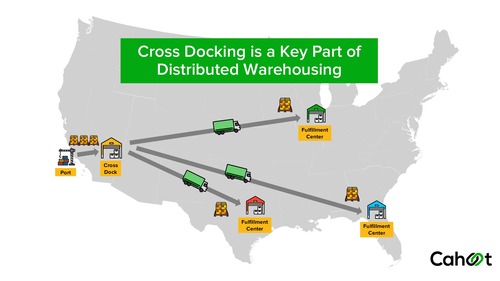
Cross-docking is a logistics process that minimizes storage and handling time by directly transferring products from inbound shipments to outbound transport. The primary goal is to reduce the time products spend in the supply chain, enhancing delivery efficiency and cutting warehousing costs. This method involves various types, such as pre-distribution, post-distribution, and continuous approaches, each supporting specific logistical needs, including Cross-docking services.
At the core of cross-docking lies in its ability to streamline the shipping process, ensuring that products move swiftly through the supply chain. Minimizing storage time leads to less inventory handling, less capital tied up in inventory for less time, and reduced warehousing costs for businesses.
What is Cross-Docking?
Cross-docking is a logistics process where products from a supplier or manufacturing plant are distributed directly to a customer or retail reseller with minimal handling and storage time. Unlike traditional warehousing, where goods are stored for extended periods, cross-docking facilities are designed for rapid movement and redistribution of goods. This approach ensures that products are sorted and dispatched almost immediately after their arrival at a logistics facility.
The primary goal of cross-docking in supply chain management is to speed up the supply chain process by reducing the need for long-term storage and minimizing handling costs. Cross-docking facilities, often referred to as cross-docks, are strategically located hubs that facilitate the direct transfer of goods from inbound to outbound transport.
Utilizing a specialized layout that minimizes storage time allows cross-docking warehouses to ensure efficient redistribution of products. This method significantly differs from traditional warehousing, focusing on fast movement and less inventory handling. The efficiency gained through cross-docking operations can lead to substantial cost savings and improved supply chain performance.
Key Steps in the Cross-Docking Workflow
The cross-docking workflow involves several key steps designed to ensure the swift movement of goods through the supply chain. It begins with receiving goods, where products are unloaded from inbound trucks at the receiving dock. This step involves minimal handling, allowing items to be quickly sorted.
Once the goods are received, they are sorted according to orders or delivery routes and redirected for immediate delivery. This sorting process is important for consolidating shipments and ensuring that products are directed to their correct destinations. The efficiency of this step is determined by the strategic layout of cross-docking facilities, which minimizes the distance goods need to travel within the warehouse. Finally, the sorted products are loaded onto outbound vehicles for delivery to their final destinations.
Slash Your Fulfillment Costs by Up to 30%
Cut shipping expenses by 30% and boost profit with Cahoot's AI-optimized fulfillment services and modern tech —no overheads and no humans required!
I'm Interested in Saving Time and MoneyAdvantages of Cross-Docking
Cross-docking offers numerous advantages that make it an attractive logistics strategy for many businesses. One of the primary benefits is cost savings, as it reduces the need for extensive warehousing and minimizes handling and storage expenses by cutting down on storage time and the number of human touches.
Another major advantage of cross-docking is improved efficiency. Facilitating the swift movement of goods from inbound to outbound shipments enhances delivery speed and reduces lead times. This approach also improves inventory management by minimizing excess inventory and reducing the risk of overstocking or stockouts. Together, these benefits contribute to a more streamlined and cost-effective supply chain operation.
Cost Savings
Cross-docking can lead to significant cost savings for businesses by reducing various expenses associated with traditional warehousing. Labor costs are decreased since products require less handling, leading to a reduced need for workforce management, resulting in cost savings in supply chain operations. Additionally, lower utility expenses result in more economical storage costs. By minimizing long-term storage and excessive handling, cross-docking helps businesses achieve a more cost-effective logistics strategy.
Improved Efficiency
Cross-docking enhances efficiency, allowing goods to move swiftly to their destinations. Allowing products to be sorted and dispatched almost immediately drastically cuts down on delivery times.
Regularly evaluating cross-docking processes helps identify areas for further simplification and even more efficiency. This continuous improvement loop ensures that the cross-docking operation remains streamlined and effective, ultimately leading to improved service levels and reduced costs.
Enhanced Inventory Management
Cross-docking minimizes the need to keep excess inventory to meet fulfillment expectations, helping businesses maintain optimal stock levels and reduce the chance of overstocking and stockout situations.
Machine learning and genAI applications in cross-docking can significantly improve demand forecasting by analyzing historical shipping data, real-time market trends, and geopolitical events to optimize inventory levels and capital spending. Leveraging advanced technologies to optimize inventory management ensures timely deliveries and reduces warehousing costs.
Cross-Docking vs Drop Shipping
Cross-docking and drop shipping are two distinct logistics strategies, each with its own set of advantages and disadvantages. Cross-docking focuses on the immediate transfer of goods between inbound and outbound transport, reducing storage duration and lowering costs associated with warehousing and handling. It improves supply chain efficiency by minimizing the need for long-term storage and reducing inventory touches.
On the other hand, drop shipping allows businesses to reduce the initial investment and ongoing costs associated with buying and holding inventory by having suppliers ship products directly to customers after the purchase is made. While this method also eliminates the need for inventory management and storage, it can lead to longer delivery times and increased transportation costs, which erodes margins and risks long-term customer loyalty typically (at least partially) attributed to fast and free shipping.
Cross-Docking vs Direct Shipment
When comparing cross-docking with direct shipment, both methods offer unique benefits and challenges. cross-docking allows fulfillment centers to ship internationally without altering their established processes, making it a versatile option for global logistics. However, one major drawback is that it can extend transit times, leading to longer customer wait times for receiving orders.
Direct shipment, or hubless shipping, allows retailers to fulfill orders directly from their warehouses to international customers, bypassing the need for a cross-dock center. This method can reduce transit times but may require more complex logistics management and higher inventory holding costs.
Cross-Docking vs. Traditional Warehousing
Cross-docking and traditional warehousing represent two different approaches to logistics management, each with its own set of advantages and disadvantages. The cross-docking process prioritizes rapid movement of goods, significantly decreasing the time required to get products from suppliers to customers. This method generally incurs lower operational costs related to physical storage space and inventory management compared to traditional warehousing.
However, traditional warehousing allows for better adaptability to changes in demand and inventory, serving as a buffer to manage variability. This flexibility can be crucial in industries with fluctuating demand patterns. And taking advantage of economies of scale and negotiating bulk purchases increases margins and profitability. But the extended margins on one side may be lost to fixed operating costs on the other, so businesses should understand the strengths and weaknesses of each approach and choose the one that best aligns with their operational goals and customer needs.
Looking for a New 3PL? Start with this Free RFP Template
Cut weeks off your selection process. Avoid pitfalls. Get the only 3PL RFP checklist built for ecommerce brands, absolutely free.
Get My Free 3PL RFPTypes of Cross-Docking
Cross-docking can be categorized into various types, each serving distinct logistical needs. The primary types include pre-distribution, post-distribution, and continuous cross-docking. Each type is defined by the timing of product sorting and the specific logistical requirements it addresses.
Pre-distribution cross-docking involves sorting goods before they arrive at the distribution center, while post-distribution cross-docking sorts products after they reach the facility. Continuous cross-docking emphasizes an uninterrupted flow of goods through the facility, ensuring rapid transfers and meeting consistent product demand.
Additionally, consolidation and deconsolidation methods facilitate direct product shipment without prior storage, optimizing fulfillment efficiency.
Pre-Distribution Cross-Docking
Pre-distribution cross-docking involves sorting goods according to their final destination before they arrive at the distribution center. In this approach, products are sorted and designated for their final destinations before arriving at the cross-dock facility. This method streamlines logistics by ensuring timely delivery based on prior customer demand.
Organizing products before they arrive at the distribution center minimizes handling and storage time, enhancing overall supply chain efficiency. This approach is particularly beneficial for industries with predictable demand patterns and well-defined delivery routes.
Post-Distribution Cross-Docking
In post-distribution cross-docking, the final destinations of goods are determined after they have reached the distribution center. This method involves sorting and allocating products to their next destinations based on real-time demand and supplier decisions. Providing more flexibility in determining shipping destinations allows post-distribution cross-docking to adapt to changing market conditions and customer needs.
This approach allows suppliers to make informed decisions about product allocation, ensuring optimal delivery routes and minimizing excess inventory. Post-distribution cross-docking is ideal for industries with variable demand patterns and the need for agile logistics management.
Continuous Cross-Docking
Continuous cross-docking is a logistics strategy that emphasizes an uninterrupted flow of goods through the facility. This process minimizes storage time as goods move directly from inbound to outbound transport without intermediate storage. Maintaining a steady flow of products facilitates rapid transfers and meets consistent product demand in continuous cross-docking.
This approach is particularly effective for high-volume industries with steady demand, such as retail and ecommerce. Continuous cross-docking ensures that products are always on the move, reducing the need for long-term storage and maximizing supply chain efficiency.
Consolidation and Deconsolidation
Consolidation and deconsolidation cross-docking are methods that facilitate direct product shipment without prior storage, enhancing transportation efficiency. In consolidation cross-docking, multiple smaller shipments are temporarily set aside and merged into a larger shipment for more efficient transport. This method reduces transportation costs by maximizing load capacity and minimizing the number of trips required.
Deconsolidation cross-docking, on the other hand, entails breaking down large shipments into smaller, easier-to-handle deliveries for further distribution. This approach is beneficial for distributing products to multiple locations or end-users.
Both methods involve some level of product handling in the warehouse, but they significantly reduce long-term storage needs and improve overall supply chain efficiency.
Cross-Docking Facilities
The design and infrastructure of cross-docking facilities play a decisive role in overall efficiency of operations. Optimizing the layout of these facilities can significantly reduce travel time and enhance material flow, ensuring that goods move swiftly from inbound to outbound shipments. Strategic layout design, including the placement of receiving docks and loading docks, is essential for minimizing the movement distance of goods.
Automation is another critical aspect of cross-docking facilities. Implementing automated systems for transferring goods can increase operational efficiency and reduce the risk of product damage. Improvements in infrastructure and technology, such as layout design optimization and automation, contribute significantly to the success of cross-docking operations.
Cross-Docking Terminals
A cross-docking terminal is a specialized facility designed for the swift movement and redistribution of shipments, differing significantly from a standard warehouse that is geared towards storing and managing inventory over a longer period. These terminals typically feature configurations like I-shaped or T-shaped layouts to facilitate numerous loading and unloading docks. Unlike traditional warehouses, cross-docking terminals have doors on both sides to streamline the unloading and loading process for efficient goods movement.
The primary focus of cross-docking terminals is to ensure rapid transfer and sorting of goods, prioritizing efficiency over long-term storage. A well-designed cross-docking facility should feature optimized layouts and adequate handling equipment to ensure efficiency.
Cross-docking terminals facilitate the quick turnover of goods and play a vital role in enhancing supply chain operations.
Role of Digital Technology
Digital technology plays a pivotal role in enhancing cross-docking operations by enabling real-time tracking and management of inventory and locations within the facility. Implementing tracking systems allows for early identification of issues, which is crucial for maintaining quality throughout the cross-docking process. Automated sorting systems are integral in cross-docking to improve efficiency by minimizing manual sorting and reducing errors in the handling process.
Companies like Walmart employ autonomous robots and real-time data analytics to optimize cross-docking workflows in their distribution centers. Advanced communication technologies, such as cloud platforms and EDI, improve real-time data sharing, enhancing coordination among all parties involved in the cross-docking process.
These technological advancements are essential for maintaining smooth and efficient cross-docking operations.
Machine Learning and Analytics
Machine learning and analytics are powerful tools that can significantly improve the accuracy of demand forecasting and analytics processes in cross-docking. By analyzing historical shipping data and patterns, machine learning algorithms can optimize inventory levels, ensuring that products are available when needed while minimizing excess inventory.
This technology enhances the overall efficiency of cross-docking operations, leading to better supply chain management and improved customer satisfaction.
Challenges and Solutions in Cross-Docking
While cross-docking offers numerous benefits, it also presents several challenges that businesses must address to ensure successful implementation. One major challenge is the complexity of coordinating various stakeholders involved in the supply chain. Effective management of multiple stakeholders is essential to ensure precise timing and operations, as delays can disrupt the entire cross-docking program and lead to disappointed customers.
Another significant challenge is the high cost associated with setting up the necessary infrastructure for cross-docking operations. Investments in advanced sorting technologies and staff training can mitigate these expenses, but the initial supply chain costs can be substantial.
Additionally, maintaining stringent quality control is crucial to ensure product integrity and customer satisfaction. By addressing these challenges, businesses can optimize their cross-docking operations to be more robust, resulting in greater operational efficiency.
Coordination Complexity
Cross-docking requires effective management of multiple stakeholders to ensure precise timing and operations. Successful cross-docking relies on precise synchronization between inbound and outbound transportation schedules, which can be challenging to achieve. Maintaining real-time communication among all stakeholders helps ensure accurate information flow and timely decision-making in cross-docking operations.
Regular assessment of cross-docking processes is essential to identify areas for improvement and adapt to changing operational demands. By continuously evaluating and refining their cross-docking practices, businesses can overcome coordination complexities.
Infrastructure Costs
Depending on the volume needs of the business, setting up a cross-docking facility can incur substantial initial investments, particularly when incorporating advanced sorting technologies, but investments in technology and staff training can mitigate these expenses. Strategic planning and resource allocation help businesses reduce the financial burden of infrastructure needs and help to achieve long-term benefits.
Despite the high initial costs, cross-docking offers significant cost savings in the long run by reducing labor, storage, and management expenses. By minimizing long-term storage and excessive handling, cross-docking helps businesses achieve a more cost-effective business model.
Quality Control
Quality control is essential in cross-docking to ensure product integrity and customer satisfaction. The quick assessment of damage during unloading allows for immediate action on compromised products, maintaining high standards of quality throughout the cross-docking process. Implementing robust quality control measures helps businesses maintain the trust and satisfaction of their customers.
Regular monitoring and evaluation of quality control processes are crucial for identifying and addressing potential issues. Maintaining stringent quality control ensures that cross-docking operations remain efficient and reliable.
Common Categories and Industries That Use Cross-Docking
Cross-docking is widely used in various industries, particularly those dealing with perishable or time-sensitive items. The retail sector, for instance, utilizes cross-docking to enhance order speed and minimize inventory costs, ensuring quick delivery of goods to consumers. Fast-moving sectors like fashion, electronics, and groceries significantly benefit from cross-docking by meeting the demands for speedy delivery.
Other industries that leverage cross-docking include food and beverage, automotive, ecommerce, and healthcare. In the automotive industry, cross-docking supports Just-in-Time manufacturing, ensuring timely delivery of components and minimizing warehousing needs. Ecommerce companies also benefit from cross-docking by streamlining their supply chains, ensuring efficient logistics and rapid fulfillment.
Best Practices for Effective Cross-Docking
Effective cross-docking implementation relies on seamless collaboration between suppliers, manufacturers, and retailers to avoid disruptions. Timely coordination between inbound and outbound shipments is critical, as delays can disrupt the entire operation. Continuous communication and real-time updates among all parties involved ensure smooth and efficient cross-docking activities.
Implementing a well-defined management system and regularly evaluating cross-docking processes are essential for overcoming logistical challenges related to timing and space management. By following best practices, businesses can achieve successful cross-docking operations and enhance their supply chain efficiency.
Efficient Scheduling
Accurate shipment scheduling is vital to ensure timely arrivals and departures and minimize idle time at cross-dock facilities. Precise scheduling is critical in cross-docking to synchronize inbound and outbound shipments and prevent operational delays. Creating a well-planned transportation schedule ensures that inbound and outbound shipments are coordinated to avoid delays and maximize throughput.
Effective scheduling helps businesses maintain a steady flow of goods, reducing the risk of bottlenecks and enhancing overall supply chain efficiency. By investing in robust scheduling systems, companies can achieve significant planning and operational benefits in their cross-docking operations.
Real-Time Communication
Maintaining continuous communication between all parties involved is crucial for the smooth execution of cross-docking. Real-time communication ensures that any issues or delays are promptly addressed, minimizing the impact on the overall operation. Advanced communication technologies, such as cloud platforms and EDI, enable instant updates and coordination among suppliers, manufacturers, and retailers, enhancing the efficiency of cross-docking processes.
Fostering open and transparent communication channels ensures that all stakeholders are aligned and informed, leading to more effective and efficient cross-docking operations. Regularly updating and refining communication protocols is essential for maintaining high standards in cross-docking activities.
Continuous Improvement
Continuous improvement in cross-docking processes is key to maintaining efficiency and customer satisfaction. Regular evaluation of cross-docking practices helps identify areas for enhancement, contributing to overall efficiency and effectiveness. By continuously refining their operations, businesses can achieve faster product turnover and quicker order fulfillment, enhancing customer satisfaction.
Implementing a culture of continuous improvement ensures that cross-docking operations remain agile and responsive to changing market conditions. Regularly assessing processes and making necessary adjustments helps businesses maintain high standards in supply chain management and achieve long-term success.
Scale Faster with the World’s First Peer-to-Peer Fulfillment Network
Tap into a nationwide network of high-performance partner warehouses — expand capacity, cut shipping costs, and reach customers 1–2 days faster.
Explore Fulfillment NetworkHow Cahoot Supports Cross-Docking: A Practical Example
Many Cahoot clients supplement their traditional warehousing and ecommerce order fulfillment operations with a cross-dock program. After setting up relationships with vendors, Sellers create large product catalogs and list the items across their sales channels. After the daily order cutoff time, (usually 5 or 6 pm local time), the list of SKUs and quantities are sent to the vendors as a purchase order where the order is picked and packed into a bulk shipment and delivered by the next morning or following day. The bulk delivery is unpacked, items are matched to orders, fulfilled same-day and handed over to carriers for final-mile delivery.
Many vendors that support these cross-docking relationships approve regional ambassadors as their go-to partners in those regions, but not in distant regions. By partnering with the Cahoot elastic warehousing network, new regions are opened up for those Sellers allowing them to ship and deliver orders faster across the nation, rather than limited to a particular region. New vendors become available, product catalogs grow and provide more opportunities for discoverability and sales, and Sellers increase revenue and profitability, besides reducing fulfillment expenses by outsourcing the remote fulfillment operations and improving margins even more.
Contact us to learn more.
Summary
Cross-docking is a powerful logistics strategy that offers numerous benefits, including cost savings, improved efficiency, and enhanced inventory management. By minimizing storage and handling time, businesses can achieve faster deliveries and reduce warehousing costs, leading to a more streamlined and cost-effective supply chain operation.
Successful cross-docking implementation requires careful planning, effective coordination, and continuous improvement. By following best practices and leveraging advanced technologies, businesses can optimize their cross-docking operations and achieve greater supply chain efficiency. As logistics and supply chain management continue to evolve, cross-docking will remain a vital strategy for businesses looking to enhance their operations and meet the demands of an increasingly competitive market.
Frequently Asked Questions
What is the primary goal of cross-docking in supply chain management?
The primary goal of cross-docking in supply chain management is to expedite the supply chain and fulfillment workflows by minimizing storage time and lowering handling costs. This approach enhances efficiency and responsiveness in product distribution.
What is cross-docking?
Cross-docking is an efficient logistics method that enables products to move directly from suppliers to customers or retailers with minimal handling and storage in between. This approach streamlines operations and reduces delivery times.
Which companies leverage cross-docking to streamline their operations?
Walmart, Toyota, and Lowe’s, among many others, all effectively utilize cross-docking to enhance their operational efficiency and reduce costs.
What are the advantages of cross-docking?
Cross-docking offers significant advantages such as expedited delivery times, minimized storage and transportation costs, and reduced labor expenses. Additionally, it lowers the risk of spoilage, damage, or theft due to limited handling of goods.
What is a cross-docking terminal?
A cross-docking terminal is a specialized facility focused on the rapid transfer and reallocation of shipments, in contrast to traditional warehouses that primarily store inventory for extended periods. This efficiency in handling logistics streamlines the supply chain process.

Turn Returns Into New Revenue

Packing Slip: Essentials & Best Practices for Accurate Shipping
In this article
 10 minutes
10 minutes
- Key Takeaways
- What is a Packing Slip?
- Key Elements of a Packing Slip
- Packing Slip vs. Other Shipping Documents
- Importance of Packing Slips in Ecommerce
- Printing and Customizing Packing Slips
- Digital Packing Slips: Advantages and Implementation
- Best Practices for Using Packing Slips
- Case Studies: Successful Use of Packing Slips
- Summary
- Frequently Asked Questions
A packing slip is essential for ensuring accurate deliveries of ecommerce orders. It provides a list of the items in a package, helping recipients confirm they’ve received everything. In this article, we’ll explain what a packing slip is, why it’s important, and how to create one that is effective.
Key Takeaways
- A packing slip is a critical document that itemizes shipment contents, aiding in order verification, inventory management, and customs clearance.
- Key elements of an effective packing slip include accurate sender and receiver details, item descriptions, quantities, and SKU numbers, ensuring clarity and order accuracy.
- Utilizing packing slips effectively enhances customer satisfaction and operational efficiency, as demonstrated by companies like Walmart and FedEx through improved inventory management and expedited customs processes.
What is a Packing Slip?
A packing slip is a document that is included inside a package that is shipped to a customer to fulfill their online order. It contains an itemized list of the products inside. Also known as a packing list, this document accompanies shipments of goods, providing detailed information about the contents of the package. The primary purpose of a packing slip is to inform the recipient about what is included in the shipment, what is intentionally missing, and why, as well as to help them verify that they have received all items as expected.
Packing slips help identify damaged items during transit, ensure order accuracy, and facilitate potential refunds. Additionally, they assist in tracking inventory levels, ensuring all ordered items are included in a shipment, confirming that it is complete and accurate. Typically, a packing slip includes details such as the order number, date of shipment, sender and recipient information, as well as an itemized list of the shipment contents.
In the context of international shipments, packing slips are used by customs to estimate the shipment’s value, further highlighting their importance. Listing all items in a shipment, packing slips ensure accurate delivery and contribute to a seamless shipping workflow.
Let AI Optimize Your Shipping and Boost Profits
Cahoot.ai software selects the best shipping option for every order—saving you time and money automatically. No Human Required.
See AI in ActionKey Elements of a Packing Slip
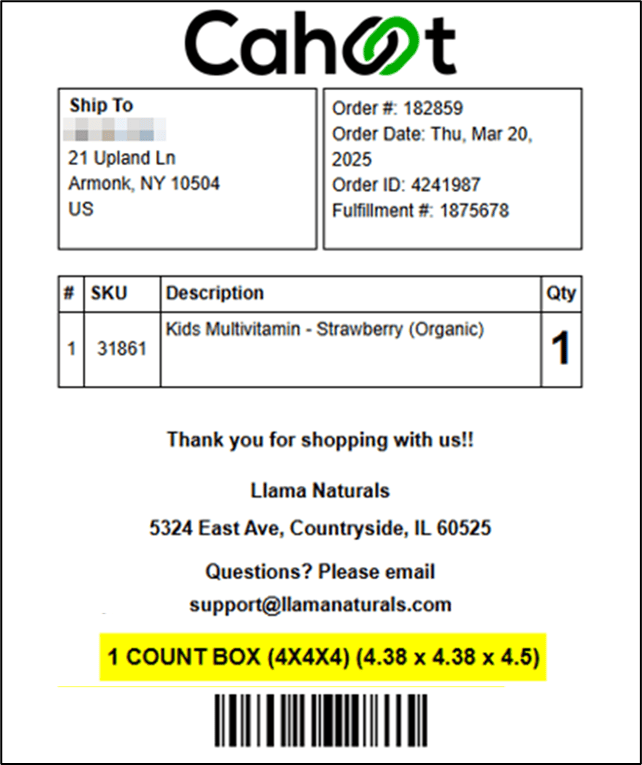
Several key elements must be included in packing slips to serve their purpose effectively. Sender’s name, address, and contact information are vital for proper identification. Accurate receiver information, including the recipient’s name, address, and any special instructions, helps avoid delivery issues.
The itemized list in a packing slip should detail each product with its name, description, quantity, and unit price for verification. Additionally, important elements like SKU numbers and customer information should be present on packing slips to avoid confusion, ensure smooth processing, and facilitate speedy customer service if needed after delivery.
Including these details helps maintain order accuracy and facilitates efficient inventory management.
Packing Slip vs. Other Shipping Documents
Packing slips serve a unique role in the shipping process, providing an itemized list of the contents within a shipment to ensure clarity and accuracy for both warehouse staff and customers. However, they are not the only documents involved in shipping; a shipping label is also essential.
Understanding their specific function involves comparing packing slips with other shipping documents like invoices, bills of lading, and delivery notes.
Difference Between a Packing Slip and an Invoice
Packing slips verify shipment contents, while invoices provide payment information. Invoices serve as formal records of transactions, including payment terms and due dates, whereas packing slips are simply meant for verifying shipment contents. Unlike invoices, packing slips do not usually display the price of the items, focusing instead on the delivery details.
Difference Between a Packing Slip and a Bill of Lading
A bill of lading acts as a legal contract between the involved parties, while a packing slip serves as an internal document summarizing shipment contents. Packing slips list the items included in the shipment without legal obligations. A bill of lading, on the other hand, signifies ownership transfer from the Seller to the buyer and is handled by the shipping company.
Packing slips detail shipment contents without payment methods or contractual obligations, while bills of lading serve as contracts and invoices request payment. This distinction highlights the unique function of packing slips.
Difference Between a Packing Slip and a Delivery Note
Packing slips provide detailed descriptions and quantities of shipped items, while delivery notes confirm the delivered items. Packing slips itemize shipped products with relevant details. Delivery notes confirm receipt without detailing discrepancies or financial information.
In summary, while packing slips provide comprehensive details about the order, delivery notes focus solely on confirming the receipt of items. This distinction further clarifies the specific roles each document plays in the shipping process.
Importance of Packing Slips in Ecommerce
In the ecommerce supply chain, packing slips serve as formal records accompanying order delivery. Recipients can verify that all items have been received compared to what was intended to be shipped, linking online orders to physical products, ensuring accuracy such that customers receive what they paid for. This verification reduces disputes and returns by allowing customers to quickly identify if their order is correct. Accurate order fulfillment and customer satisfaction depend on this verification process.
Some packing slips display Quantity on Hand, which enables warehouse staff to physically confirm how many units of each product are available during the shipping workflow; a mini cycle count of sorts. These documents help track shipped items, making inventory management more accurate. Therefore, packing slips help businesses maintain accurate inventory levels so they create purchase orders to replenish depleting items when necessary.
Accurate packing slips serve as an extension of a brand, providing an opportunity for customer engagement during the unboxing experience. Including warranty details or return instructions can clarify procedures and reduce customer service time. Showing care in fulfillment accuracy satisfies customer expectations and leads to repeat customer orders.
ShipStation vs. Cahoot: 21x Faster, Real Results
Get the inside scoop on how a leading merchant switched from ShipStation to Cahoot—and what happened next. See it to believe it!
See the 21x DifferencePrinting and Customizing Packing Slips
Methods to print packing slips include Excel templates, shipping software, and integrated ecommerce platforms. Customizing packing slips enhances brand identity and improves customer engagement. Customization ideas include adding logos, colors, product images, and promotional messages.
Methods to Print Packing Slips
Adobe Commerce, Shopify, Amazon, and eBay support printing packing slips. They can also be printed directly from online marketplaces like Etsy and WooCommerce. Dedicated shipping software allows batch printing for multiple orders, streamlining the process.
Tools for professional packing slips include DIY packing slip templates in Excel and Google Sheets, labeling services, and inventory management software.
Customizing Packing Slips
Customizing packing slips creates a cohesive brand experience, enhances customer engagement, and improves retention. Enhancements can include logos, colors, product images, and promotional offers or social media prompts. Strategies include offering discounts, exclusive coupons, or promoting new products and upcoming sales.
High-quality paper can positively impact customers’ perceptions of the brand. Eco-friendly materials align with sustainable branding efforts. Incorporating customer names or gift messages on packing slips can enhance the personal touch and improve customer experience.
Custom packing slips can also feature seasonal themes to resonate with customers during holidays.
Digital Packing Slips: Advantages and Implementation
Digital packing slips offer several advantages over traditional versions. They reduce paper waste, provide faster access to details, and streamline delivery. Amazon’s transition to digital packing slips, for example, reduced paper usage by 30% within a year and streamlined the packing process by removing steps. Using digital versions or recycled materials promotes sustainability, appealing to environmentally-conscious customers.
They can also include QR codes linking to product reviews or additional information, such as product demos. This feature facilitates easy access to online resources, enhancing customer experience and engagement.
Implementing digital packing slips not only benefits the environment but also boosts operational efficiency and customer satisfaction.
Best Practices for Using Packing Slips
Standard practices for packing slips can significantly enhance shipping efficiency and accuracy. Effective packing slips serve as checklists detailing shipment contents, improving accuracy and efficiency. Using a customizable packing slip template can streamline their creation, printing, and automating generation and printing minimizes errors and adds efficiency gains.
Double-Checking Information
Verifying the accuracy of information on packing slips helps prevent shipping errors. Double-checking item quantities and descriptions avoids mistakes and confusion during shipping. Accurate packing slip information before dispatch reduces discrepancies and ensures the correct items are shipped.
Including All Necessary Details
A packing slip should include Buyer and Seller information, item descriptions, quantities, weights, SKU or UPC codes, and the shipping address.
Keeping Consistent Formats
A uniform format streamlines fulfillment and reduces mistakes. A consistent layout and design imply professionalism and clarity. Standardized formats streamline operations and reduce errors by providing repeatable consistency, making the process more efficient.
Cut Costs with the Smartest Shipping On the Market
Guranteed Savings on EVERY shipment with Cahoot's AI-powered rate shopping and humanless label generation. Even for your complex orders.
Cut Costs TodayCase Studies: Successful Use of Packing Slips
Case studies from companies like Walmart and FedEx demonstrate the benefits of using packing slips effectively. Integrating packing slips with inventory management systems has led to remarkable improvements in operational efficiency and customer satisfaction.
Walmart’s Inventory Management Integration
Walmart achieved a 15% decrease in inventory errors and improved operational agility by integrating packing slips with its inventory management system.
FedEx’s Customs Clearance Efficiency
FedEx automated the creation of packing slips, which helped reduce the time required for customs clearance and reduced customs clearance delays by 20%, enhancing overall shipping efficiency and delivery times.
Summary
Packing slips are indispensable tools in the shipping process, providing detailed information about the contents of a package and ensuring order accuracy. They play a vital role in inventory management, customer satisfaction, and operational efficiency. By understanding the differences between packing slips and other shipping documents, businesses can utilize them more effectively to streamline their shipping processes and enhance customer trust.
Implementing best practices for creating and using packing slips, such as double-checking information, including all necessary details, and maintaining consistent formats, can significantly improve shipping accuracy and efficiency. The case studies of Walmart and FedEx illustrate the tangible benefits of integrating packing slips with inventory systems and automating their generation for customs clearance. Embracing these practices can lead to smoother operations, fewer errors, and happier customers.
Frequently Asked Questions
What is the difference between a packing slip and a delivery slip?
The key difference between a packing slip and a delivery slip lies in their purpose: a packing slip details the contents of the shipment, while a delivery slip, or delivery note, serves as proof of delivery and typically requires a signature. Thus, a packing slip focuses on item details, whereas a delivery slip confirms successful delivery.
What is a packing slip?
A packing slip is a document that itemizes all the products included in a package, serving as a reference for both the sender and the recipient. It contains essential details like SKU numbers and quantities to ensure accurate order fulfillment.
What information is typically included on a packing slip?
Packing slips typically include buyer and order information, a list of items with quantities, product weight, and SKU or UPC codes. This ensures clarity and organization during the shipping process, which in turn minimizes fulfillment mistakes.
What role do packing slips play in increasing customer satisfaction?
Packing slips show that a business values accuracy in fulfilling orders, engendering trust with customers and encouraging repeat purchases.

Turn Returns Into New Revenue




